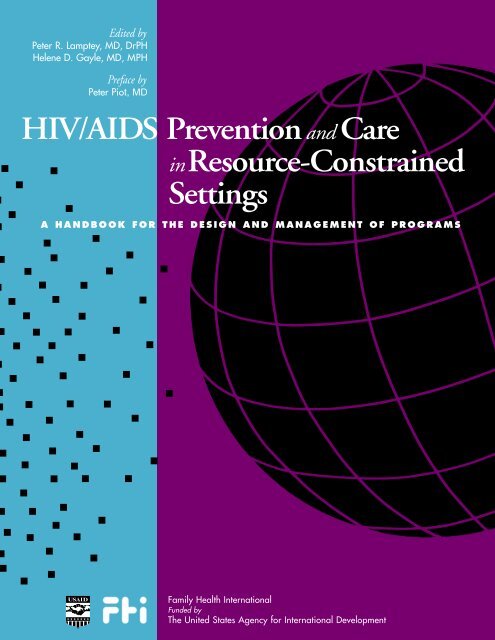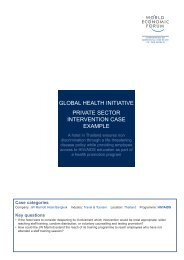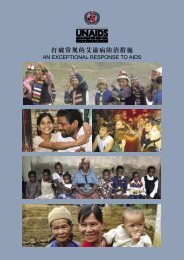X HIV/AIDS Prevention and Care in Resource-Constrained Settings
X HIV/AIDS Prevention and Care in Resource-Constrained Settings
X HIV/AIDS Prevention and Care in Resource-Constrained Settings
- No tags were found...
Create successful ePaper yourself
Turn your PDF publications into a flip-book with our unique Google optimized e-Paper software.
Edited byPeter R. Lamptey, MD, DrPHHelene D. Gayle, MD, MPHPreface byPeter Piot, MD<strong>HIV</strong>/<strong>AIDS</strong> <strong>Prevention</strong> <strong>and</strong> <strong>Care</strong><strong>in</strong> <strong>Resource</strong>-Constra<strong>in</strong>edSett<strong>in</strong>gsA HANDBOOK FOR THE DESIGN AND MANAGEMENT OF PROGRAMSFamily Health InternationalFunded byThe United States Agency for International Development
<strong>HIV</strong>/<strong>AIDS</strong> <strong>Prevention</strong> <strong>and</strong> <strong>Care</strong><strong>in</strong><strong>Resource</strong>-Constra<strong>in</strong>edSett<strong>in</strong>gsA HANDBOOK FOR THE DESIGN AND MANAGEMENT OF PROGRAMSEditorsPeter R. Lamptey, MD, DrPHExecutive Vice President/COO<strong>HIV</strong>/<strong>AIDS</strong> <strong>Prevention</strong> <strong>and</strong> <strong>Care</strong> DepartmentFamily Health InternationalArl<strong>in</strong>gton, VA U.S.A.Helene D. Gayle, MD, MPHSenior Advisor for <strong>HIV</strong>/<strong>AIDS</strong>Bill <strong>and</strong> Mel<strong>in</strong>da Gates FoundationSeattle, WA U.S.A.Coord<strong>in</strong>ators:Kristen Ruckstuhl, MAMadal<strong>in</strong>e Fe<strong>in</strong>berg, MAConsult<strong>in</strong>g Editors:John-Manuel Andriote, MSCathar<strong>in</strong>e P. Farr<strong>in</strong>gton, MS
© 2001 Family Health International (FHI). Allrights reserved. This book may be freely reviewed,quoted, reproduced or translated, <strong>in</strong> full or <strong>in</strong>part, provided the source is acknowledged. Thisbook may not be sold or used <strong>in</strong> conjunction withcommercial purposes.The views expressed <strong>in</strong> this book by namedauthors are solely the responsibility of thoseauthors <strong>and</strong> do not necessarily reflect the views ofFHI or the United States Agency for InternationalDevelopment (USAID). The mention of specificcompanies or products implies no endorsement<strong>and</strong> does not suggest that they are recommendedby FHI or USAID over others of a similar naturethat are not mentioned.This work was supported <strong>in</strong> part by theUnited States Agency for InternationalDevelopment (USAID) as part of Family HealthInternational’s (FHI) Implement<strong>in</strong>g <strong>AIDS</strong> <strong>Prevention</strong><strong>and</strong> <strong>Care</strong> (IMPACT) Project (CoorperativeAgreement HRN-A-00-97-0017-00).Family Health InternationalFHI <strong>AIDS</strong> Institute2101 Wilson BoulevardArl<strong>in</strong>gton, VA 22201, U.S.A.Telephone: 1-703-516-9779Fax: 1-703-516-9781Internet: http://www.fhi.orgISBN: 1-931547-02-5
table of C O N T E N T SPrefacePAGE VIntroductionPAGE VIIAchnowledgementsPAGE XXVISection EditorsPAGE XXVIAuthors, Reviewers<strong>and</strong> Section EditorsPAGE XXVIIGlossary of AcronymsPAGE XXXIIISECTION I:Chapter 1PAGE 1Chapter 2PAGE 35Chapter 3PAGE 55Chapter 4PAGE 85Chapter 5PAGE 111Peter Piot, MDPaul R. DeLay, MDKaren StaneckiGunilla EmbergDesign <strong>and</strong> Management of<strong>HIV</strong>/<strong>AIDS</strong> ProgramsSTRATEGIC PLANNING, PROGRAM DESIGNAND MANAGEMENTClement ChanKam MB, MRCPGail Goodridge, MSRob Moodie, MBBS, MPHAPPROACHES TO ECONOMIC EVALUATIONOF <strong>HIV</strong>/<strong>AIDS</strong> INTERVENTIONSSteven Forsythe, PhDRESPONDING TO THE SOCIOECONOMICIMPACT OF <strong>HIV</strong>/<strong>AIDS</strong>Anthony K<strong>in</strong>ghorn, MBBChAlan Whiteside, MAMalcolm Ste<strong>in</strong>berg, MBBCh, MScIMPROVING ACCESS TO DRUGS FORPEOPLE LIVING WITH <strong>HIV</strong>/<strong>AIDS</strong>Françoise Renaud Thery, PharmD, Dip Public HealthJonathan D. Quick, MD, MPHEVALUATION AND SURVEILLANCEAPPROACHES FOR <strong>HIV</strong>/<strong>AIDS</strong> PROGRAMSThomas M. Rehle, MD, PhDEmil Asamoah Odei, MB, ChB, MSc, Dip VenMichel Carael, PhDBernhard Schwartländer, MD, PhD<strong>HIV</strong>/<strong>AIDS</strong> <strong>Prevention</strong> <strong>and</strong> <strong>Care</strong> <strong>in</strong> <strong>Resource</strong>-Constra<strong>in</strong>ed Sett<strong>in</strong>gs I
SECTION II:Chapter 6PAGE 137Chapter 7PAGE 159Chapter 8PAGE 187Chapter 9PAGE 211Chapter 10PAGE 229Chapter 11PAGE 259Reduc<strong>in</strong>g Risk <strong>and</strong>Vulnerability to <strong>HIV</strong> InfectionBEHAVIOR CHANGE COMMUNICATIONTO REDUCE RISK AND VULNERABILITY INRESOURCE-CONSTRAINED SETTINGSCarol Larivee, MABarbara A.K. Frankl<strong>in</strong>, MDYOUTH INTERVENTION PROGRAMSArletty P<strong>in</strong>el, MDGary R. Svenson, MSW, MScHilary Hughes, MPhil/PhD (c<strong>and</strong>idate)REDUCING <strong>HIV</strong> RISK IN SEX WORKERS,THEIR CLIENTS AND PARTNERSBea Vuylsteke, MD, MScSmrajit Jana, MD<strong>HIV</strong>/<strong>AIDS</strong> PROGRAMS IN PRIVATESECTOR BUSINESSESAnthony PramualratanaBill Rau, PhDPROGRAMS FOR MOBILE POPULATIONSAND THEIR PARTNERSIvan Wolffers, MD, PhDThomas M. Pa<strong>in</strong>ter, PhDREACHING MEN WHO HAVE SEX WITH MENRichard Parker, PhDCarlos F. Cáceres, MD, DrPHShivan<strong>and</strong>a KhanPeter Aggleton, PhD, FBPsS, FRSH, FRIPHHChapter 12 SOCIAL MARKETING: TWO APPROACHESPAGE 281 TO <strong>HIV</strong>/<strong>AIDS</strong> PREVENTIONWilliam SmithChapter 13PAGE 305 Bill Rau, PhD<strong>AIDS</strong> AND DEVELOPMENTAL CONSTRAINTSII <strong>HIV</strong>/<strong>AIDS</strong> <strong>Prevention</strong> <strong>and</strong> <strong>Care</strong> <strong>in</strong> <strong>Resource</strong>-Constra<strong>in</strong>ed Sett<strong>in</strong>gs
SECTION III:Chapter 14PAGE 321Chapter 15PAGE 359Chapter 16PAGE 381SECTION IV:Chapter 17PAGE 407Chapter 18PAGE 427Chapter 19PAGE 451SECTION V:Chapter 20PAGE 477Strengthen<strong>in</strong>g STDManagement <strong>and</strong> ServicesSTD CASE MANAGEMENT IN PRIMARYHEALTH CARE SETTINGSPhilippe Mayaud, MD, MScFrancis Ndowa, MBChB, Dip Derm, Dip GUMedISSUES IN STD CONTROL FORSPECIAL GROUPSRichard Steen, PA, MPHAntonio C. Gerbase, MD, MSSTD PROGRAM MANAGEMENT ANDEVALUATIONFrançois Crabbé, MD, MPHJohn Gallwey, MB, ChBReduc<strong>in</strong>g Risk of <strong>HIV</strong>Transmission to InfantsREDUCING <strong>HIV</strong> INFECTION IN WOMENAND PROVIDING FAMILY PLANNINGSERVICES TO WOMEN AT RISKIsabelle de Zoysa, MD, MScGeorgette Adjorlolo Johnson, MD, MPHREDUCING THE RISK OF MOTHER-TO-CHILDTRANSMISSION OF <strong>HIV</strong> DURINGPREGNANCY AND DELIVERYIsabelle de V<strong>in</strong>cenzi, MD, PhDEhounou Ekp<strong>in</strong>i, MDMOTHER-TO-CHILD TRANSMISSION OF <strong>HIV</strong>THROUGH BREASTFEEDING:STRATEGIES FOR PREVENTIONRuth Nduati, MBCHB, MMED, MPHJay Ross, PhDReduc<strong>in</strong>g Risk of ParenteralTransmissionENSURING THE SAFETY OF BLOODAND BLOOD PRODUCTSEve Lackritz, MDBrian McClell<strong>and</strong>, BSc Hons, MBChB, MRCP,Doctoraat <strong>in</strong> de Geneeskunde, FRCP, FRC Path<strong>HIV</strong>/<strong>AIDS</strong> <strong>Prevention</strong> <strong>and</strong> <strong>Care</strong> <strong>in</strong> <strong>Resource</strong>-Constra<strong>in</strong>ed Sett<strong>in</strong>gs III
Chapter 21PAGE 501Chapter 22PAGE 517SECTION VI:Chapter 23PAGE 547Chapter 24PAGE 579Chapter 25PAGE 603Chapter 26PAGE 629Chapter 27PAGE 661SECTION VII:Chapter 28PAGE 679TRANSMISSION OF <strong>HIV</strong> IN HEALTHCARE SETTINGSDenise M. Cardo, MDAnne Buve, MD<strong>HIV</strong> RISK REDUCTION IN INJECTIONDRUG USERSAndrew Ball, MBNick Crofts, MB, MPH, FAFPHMManagement <strong>and</strong> Support of PeopleInfected <strong>and</strong> Affected by <strong>HIV</strong>/<strong>AIDS</strong>COUNSELING, TESTING ANDPSYCHOSOCIAL SUPPORTRachel Baggaley, MSC, MDIgnatius KayaweDavid Miller, PhDHOME CARE FOR PEOPLE WITH <strong>AIDS</strong>Helen JacksonS<strong>and</strong>ra AndersonMANAGEMENT OF <strong>HIV</strong> DISEASEAND ITS COMPLICATIONS IN RESOURCE-CONSTRAINED SETTINGSRobert Colebunders, MD, PhDEric van Praag, MD, MPHJoseph Perriens, MD, PhDORPHANS AND OTHER VULNERABLECHILDREN: APPROACHES TO CARE ANDPROTECTION PROGRAMSSusan S. Hunter, PhDSusan Parry, MD<strong>HIV</strong>/<strong>AIDS</strong>, HEALTH AND HUMAN RIGHTSSofia Grusk<strong>in</strong>, JD, MIADaniel Tarantola, MDProspects for the FutureFUTURE CHALLENGES IN <strong>HIV</strong>/<strong>AIDS</strong>PREVENTION AND CAREHelene Gayle, MD, MPHPeter Lamptey, MD, DrP<strong>HIV</strong> <strong>HIV</strong>/<strong>AIDS</strong> <strong>Prevention</strong> <strong>and</strong> <strong>Care</strong> <strong>in</strong> <strong>Resource</strong>-Constra<strong>in</strong>ed Sett<strong>in</strong>gs
PREFACEIn 20 years of responses to the <strong>AIDS</strong> p<strong>and</strong>emic theworld has learned many hard lessons. We havelearned that half-measures do not work: progress ismade only when communities <strong>and</strong> nations wholeheartedlyembrace the fight aga<strong>in</strong>st <strong>AIDS</strong>. We havelearned that there is no “one-size-fits-all” solution <strong>in</strong>design<strong>in</strong>g <strong>and</strong> deliver<strong>in</strong>g the most effective prevention<strong>and</strong> care <strong>in</strong>itiatives. We have learned that <strong>HIV</strong> feedson social <strong>in</strong>equality, especially the <strong>in</strong>equality betweenmen <strong>and</strong> women. This is why we must confront theneed for long-term, structural change to effectivelyaddress the p<strong>and</strong>emic.Above all, we have learned that we are not powerlessto change the course of the p<strong>and</strong>emic.Communities <strong>and</strong> whole nations have demonstratedthat it is possible to reduce the spread of <strong>HIV</strong>.Many have taken action before the epidemic has takenhold, but others have managed to pull back the epidemiceven <strong>in</strong> their countries after its growth to devastat<strong>in</strong>gscale. And while scientists cont<strong>in</strong>ue work<strong>in</strong>g tof<strong>in</strong>d a cure or an effective vacc<strong>in</strong>e, great advances havebeen made <strong>in</strong> care <strong>and</strong> treatment. Where these havebeen with<strong>in</strong> f<strong>in</strong>ancial reach they have immenselyimproved the quality of life of people liv<strong>in</strong>g with<strong>HIV</strong>/<strong>AIDS</strong> (PLHA).This H<strong>and</strong>book is a valuable tool for extend<strong>in</strong>gthe reach of effective responses to <strong>HIV</strong>/<strong>AIDS</strong> wherethey are needed most. There are 40 million PLHA<strong>in</strong> the world today, <strong>and</strong> 95 percent live <strong>in</strong> resourceconstra<strong>in</strong>edcountries. Until <strong>and</strong> unless the impact of<strong>AIDS</strong> is reduced, these countries face little prospect ofbuild<strong>in</strong>g a more secure <strong>and</strong> prosperous future.While every community needs to devise the prevention<strong>and</strong> care solutions that are most effective <strong>in</strong> itsown local context, there are some universal pr<strong>in</strong>cipleson which success has been built:■ Leadership is required at every level of society toensure a comprehensive <strong>and</strong> coord<strong>in</strong>ated effortaga<strong>in</strong>st <strong>HIV</strong>/<strong>AIDS</strong>. Leadership is the key to lift<strong>in</strong>gthe veils of denial <strong>and</strong> discrim<strong>in</strong>ation as well as tomobiliz<strong>in</strong>g resources <strong>and</strong> creat<strong>in</strong>g synergy betweendifferent elements of the response.■ We must know what drives the p<strong>and</strong>emic torespond effectively to it. This means underst<strong>and</strong><strong>in</strong>gpatterns of sexual practice <strong>and</strong> drug use, as wellas the distribution of <strong>HIV</strong> <strong>in</strong>fection.■ <strong>Prevention</strong> <strong>and</strong> care are not compet<strong>in</strong>g priorities;they are mutually re<strong>in</strong>forc<strong>in</strong>g strategies.Extend<strong>in</strong>g access to comprehensive care, <strong>in</strong>clud<strong>in</strong>gantiretroviral therapy, is a priority even <strong>in</strong> the mostresource-constra<strong>in</strong>ed sett<strong>in</strong>gs, because it br<strong>in</strong>gsrenewed hope <strong>and</strong> greater energy to the response.■ Social exclusion must be tackled as one of thedrivers of the p<strong>and</strong>emic. People are more vulnerableto <strong>HIV</strong> when they are deprived of respect <strong>and</strong>community support. The most successful responsestrategies are those that have given a lead<strong>in</strong>g role toPLHA <strong>and</strong> others seen to be most at risk.■ At this stage <strong>in</strong> the global p<strong>and</strong>emic the overwhelm<strong>in</strong>gneed is for an <strong>in</strong>crease <strong>in</strong> the scale ofresponses. An <strong>AIDS</strong> response must take rootacross every region, throughout every nation, fromtown to town <strong>and</strong> village to village.Revers<strong>in</strong>g the <strong>AIDS</strong> p<strong>and</strong>emic is about chang<strong>in</strong>gthe world we live <strong>in</strong>—our behaviors <strong>and</strong> relationships,where money flows <strong>and</strong> who makes decisions. Itrequires every one of us to play our part.PETER PIOT, MDExecutive DirectorJo<strong>in</strong>t United Nations Programme on <strong>HIV</strong>/<strong>AIDS</strong>(UN<strong>AIDS</strong>)<strong>HIV</strong>/<strong>AIDS</strong> <strong>Prevention</strong> <strong>and</strong> <strong>Care</strong> <strong>in</strong> <strong>Resource</strong>-Constra<strong>in</strong>ed Sett<strong>in</strong>gs V
I N T R O D U C T I O NPAUL R. DE LAYGUNILA ERNBERGKAREN STANECKI
INTRODUCTIONWe are <strong>in</strong> the third decade of what hasbecome the most important <strong>in</strong>fectiousdisease epidemic of the last century. S<strong>in</strong>ce<strong>AIDS</strong> was first recognized <strong>in</strong> 1981, an estimated 60million men, women <strong>and</strong> children have become<strong>in</strong>fected with the virus worldwide. Nearly half of allpersons who acquire <strong>HIV</strong> are under age 25 <strong>and</strong> mostwill die before they reach 35. As of the end of 2000,22 million people had died of <strong>AIDS</strong>. Approximately13 million children under age 15 have lost one orboth parents to <strong>AIDS</strong>, <strong>and</strong> the number of <strong>AIDS</strong>orphans is expected to exceed 40 million by 2010.<strong>HIV</strong>/<strong>AIDS</strong> is now the fourth lead<strong>in</strong>g cause of deathworldwide, <strong>and</strong> the s<strong>in</strong>gle lead<strong>in</strong>g cause of death <strong>in</strong>sub-Saharan Africa.Over the past 20 years, we have cont<strong>in</strong>ued to besurprised, shocked <strong>and</strong> devastated by this p<strong>and</strong>emic,which the global community has consistently underestimated.We have underestimated the level of <strong>HIV</strong>prevalence that has been atta<strong>in</strong>ed <strong>in</strong> some generaladult populations (such as <strong>in</strong> Botswana <strong>and</strong>Zimbabwe); the scope of the p<strong>and</strong>emic around theworld (<strong>HIV</strong> <strong>in</strong>fection is now found <strong>in</strong> even the mostremote <strong>and</strong> isolated countries such as Bhutan <strong>and</strong>Mongolia); <strong>and</strong> the rapid growth of specific countryepidemics (such as those <strong>in</strong> Cambodia <strong>and</strong> the countriesof Southern Africa). At the beg<strong>in</strong>n<strong>in</strong>g of the 21stcentury, <strong>HIV</strong>/<strong>AIDS</strong> prevalence among adults hasexceeded 20 percent <strong>in</strong> seven countries <strong>in</strong> the develop<strong>in</strong>gworld—all <strong>in</strong> Africa—<strong>and</strong> is above 10 percent <strong>in</strong>n<strong>in</strong>e additional countries. In another 38 countries,prevalence equals or exceeds one percent; 22 of theseare <strong>in</strong> Africa, 11 <strong>in</strong> Lat<strong>in</strong> America, four <strong>in</strong> Asia <strong>and</strong>one <strong>in</strong> Eurasia. In contrast, <strong>HIV</strong>/<strong>AIDS</strong> prevalence <strong>in</strong>the United States was 0.6 percent at the end of 2000.<strong>AIDS</strong> was first described <strong>in</strong> 1981, <strong>and</strong> it appearslikely that the virus is less than 100 years old. It istheorized that the various stra<strong>in</strong>s <strong>and</strong> subtypes of <strong>HIV</strong>orig<strong>in</strong>ated through multiple mutations of animalretroviruses, which facilitated a “species leap” tohumans. Through back-estimat<strong>in</strong>g the time needed toachieve the exist<strong>in</strong>g varieties of viral mutations, itappears this jump from animal to humans probablyoccurred <strong>in</strong> the late 1930s or early 1940s. The mutationsthat resulted <strong>in</strong> <strong>HIV</strong>-1 most likely arose <strong>in</strong> westcentralAfrica, <strong>in</strong> the countries of Gabon, EquatorialGu<strong>in</strong>ea <strong>and</strong> Cameroon. What occurred after humansbecame <strong>in</strong>fected demonstrates a pattern that we haveseen repeatedly throughout the world. Due to theupheavals that were occurr<strong>in</strong>g <strong>in</strong> the Belgian Congodur<strong>in</strong>g the 1950s, it is likely that the earliest <strong>in</strong>fectedhumans seeded the Great Lakes region of the AfricanRift Valley. Mass movements of people, disruptions offamilies <strong>and</strong> culture, chang<strong>in</strong>g sexual behavior, an<strong>in</strong>crease of other risk behaviors <strong>and</strong> fluxes <strong>in</strong> economicstatus have all fueled the p<strong>and</strong>emic—<strong>in</strong> Africa <strong>and</strong>around the world. Because <strong>HIV</strong> is new to humanity,we still have much to learn.PAUL R. DE LAYGUNILA ERNBERGKAREN STANECKI<strong>HIV</strong>/<strong>AIDS</strong> <strong>Prevention</strong> <strong>and</strong> <strong>Care</strong> <strong>in</strong> <strong>Resource</strong>-Constra<strong>in</strong>ed Sett<strong>in</strong>gs VII
F igure 1Factors That InfluenceThe Spread of <strong>HIV</strong>Viral Factors■ <strong>HIV</strong>-1 stra<strong>in</strong>s■ ViremiaLocal Genital Factors■ Presence of STDs■ Male cicumcision■ Use of vag<strong>in</strong>al productsSexual Behavior■ Rate of partner exchange■ Sexual mix<strong>in</strong>g patterns■ Type of <strong>in</strong>tercourse■ Size <strong>and</strong> rate of contact with core groups■ Level of condom useDemographic Factors■ Percentage of sexually active age groups toother age groups■ Male to female ratio■ Urban: rural percentage■ Migration patternsEconomic <strong>and</strong> Political Factors■ Level of poverty■ War <strong>and</strong> social conflicts■ Status of transport <strong>and</strong> mobility of population■ Performance of health care system■ Response to epidemic(from Piot-1994)STATUS AND TRENDS OFTHE <strong>HIV</strong>/<strong>AIDS</strong> EPIDEMICSAlthough the <strong>AIDS</strong> p<strong>and</strong>emic is complex, track<strong>in</strong>g<strong>and</strong> analyz<strong>in</strong>g its evolution <strong>and</strong> diversity enables us to<strong>in</strong>tervene more effectively <strong>and</strong> to more accuratelypredict future trends. We assumed <strong>in</strong> the late 1980sthat any country with evidence of widespread riskconditions for <strong>HIV</strong> transmission would <strong>in</strong>evitablysuffer an extensive epidemic once <strong>HIV</strong> was <strong>in</strong>troduced<strong>in</strong>to the population. This “evidence” of risk behaviors<strong>in</strong>cluded the presence of a commercial sex <strong>in</strong>dustry,high background prevalence of other sexually transmitteddiseases (STDs) <strong>in</strong> the population, low condomuse by men <strong>and</strong> the existence of <strong>in</strong>jection druguse (IDU). But this was a far too simplistic view of theunderly<strong>in</strong>g dynamics of the p<strong>and</strong>emic. In Asia, forexample, we have seen the epidemic explode <strong>in</strong>Cambodia, Burma, Thail<strong>and</strong> <strong>and</strong> <strong>in</strong> some states ofIndia, yet rema<strong>in</strong> very concentrated <strong>and</strong> <strong>in</strong> low prevalence<strong>in</strong> the Philipp<strong>in</strong>es <strong>and</strong> Indonesia.The p<strong>and</strong>emic cont<strong>in</strong>ues to defy simple models<strong>and</strong> formulas. We now recognize that there are anumber of host, viral <strong>and</strong> social factors that determ<strong>in</strong>etransmission <strong>and</strong> vulnerability. These <strong>in</strong>teract <strong>in</strong> acomplex manner <strong>in</strong> the mosaic of global sett<strong>in</strong>gs.Figure 1 lists the most predom<strong>in</strong>ant determ<strong>in</strong>ants.It has become <strong>in</strong>creas<strong>in</strong>gly important to <strong>in</strong>tegrateimproved biological surveillance data with detailed<strong>in</strong>formation about the social <strong>and</strong> economic patternsthat lead to <strong>in</strong>creased risk behaviors <strong>and</strong> vulnerability.These “second generation” surveillance systems willimprove our ability to describe the state of local epidemics<strong>and</strong> target our <strong>in</strong>terventions for the future. Butit is challeng<strong>in</strong>g to collect this range <strong>and</strong> depth of datafor each country. Among this array of determ<strong>in</strong>ants,there are a number of predom<strong>in</strong>ant factors. Sexualbehaviors <strong>and</strong> the pattern of sexual networks areclearly the most important factors <strong>in</strong> the most severesexually transmitted epidemics. We have recentlylearned that subtle quantitative differences <strong>in</strong> behaviorcan either cause the epidemic to explode or stabilize ata relatively low level of prevalence. It is not a matterof whether commercial or casual sex exists <strong>in</strong> a society,but how much, of what k<strong>in</strong>ds, when it is practiced<strong>and</strong> by whom.Besides risk behavior patterns, there are <strong>in</strong>creas<strong>in</strong>gdata on the possible role of STDs, <strong>HIV</strong>-1 subtypes<strong>and</strong> male circumcision <strong>in</strong> the efficiency of variousVIII <strong>HIV</strong>/<strong>AIDS</strong> <strong>Prevention</strong> <strong>and</strong> <strong>Care</strong> <strong>in</strong> <strong>Resource</strong>-Constra<strong>in</strong>ed Sett<strong>in</strong>gs
F igure 2Comparison of Average Number of Clients PerCommercial Sex Worker (CSW) Versus Percentageof Young Men Who Utilized Sex WorkersAverage # of CSW clients/day43.532.521.510.50■ Indonesia■ Philipp<strong>in</strong>es■ Cambodia■ Thail<strong>and</strong>0 10 20 30 40 50 60% of males us<strong>in</strong>g sex workersmodes of transmission. These have yet to be adequatelydel<strong>in</strong>eated <strong>and</strong> entered <strong>in</strong>to the complex equation ofepidemic dynamics.T HE EPIDEMICS OFSUB-SAHARAN AFRICAThe global p<strong>and</strong>emic consists of a mosaic of <strong>in</strong>dividualepidemics <strong>in</strong> countries around the world. Theoldest set of epidemics can be found <strong>in</strong> sub-SaharanAfrica. Of the 36 million people liv<strong>in</strong>g with<strong>HIV</strong>/<strong>AIDS</strong> globally, more than 25 million (70 percent)are <strong>in</strong> sub-Saharan Africa. This region <strong>in</strong>cludesonly 11 percent of the world’s population. Nearly one<strong>in</strong> 10 adults between the ages of 15 <strong>and</strong> 49 is alreadyliv<strong>in</strong>g with the virus throughout the sub-cont<strong>in</strong>ent.In Africa women are harder hit than men, theopposite of what is found on all other cont<strong>in</strong>ents. Thedifference between men <strong>and</strong> women is most pronounced<strong>in</strong> those under age 25. A population-basedsurvey <strong>in</strong> Kisumu, Kenya, showed <strong>HIV</strong> rates <strong>in</strong> 15-<strong>and</strong> 16-year-old girls of 8 percent <strong>and</strong> 18 percent,while no <strong>in</strong>fections were documented <strong>in</strong> boys of thesame age. In 19-year-old girls the rates were up to 33percent, <strong>and</strong> only 9 percent <strong>in</strong>boys. We do not fully underst<strong>and</strong>the reasons for these extremelyhigh rates <strong>in</strong> girls. Young girls’biological vulnerability <strong>and</strong> the factthat girls frequently have sex partnersof much higher age—withhigh levels of <strong>in</strong>fection—likely playa role.There are at least three patternsof transmission <strong>in</strong> sub-SaharanAfrica:In the countries of EastAfrica, the oldest <strong>HIV</strong> epidemics<strong>in</strong> the world have had slow, steadyprogress over the past 30 years.These are seen <strong>in</strong> the Great Lakesregions of East Africa—<strong>in</strong> thecountries of Ug<strong>and</strong>a, Tanzania,Malawi, Kenya, Zambia <strong>and</strong> the Democratic Republicof the Congo (formerly Zaire).In the countries of West Africa, where theepidemic seems to have started about 10 years later,progression of the epidemic has been more <strong>in</strong>dolent<strong>and</strong> is further complicated by the presence of both<strong>HIV</strong>-1 <strong>and</strong> <strong>HIV</strong>-2. The national prevalence ratesare generally lower, between one percent <strong>and</strong> eightpercent, except for Côte d’Ivoire.In Southern Africa, where the epidemic started<strong>in</strong> the mid-to late 1980s, there has been a series ofexplosive epidemics over the past eight years, reach<strong>in</strong>gthe highest prevalence levels on earth, 20 percent to40 percent. These countries <strong>in</strong>clude South Africa,Namibia, Zimbabwe, Botswana, Swazil<strong>and</strong> <strong>and</strong>Lesotho.Among the features of the epidemics <strong>in</strong> this region:■■Half of new <strong>in</strong>fections <strong>in</strong> Africa are among 16- to23-year-olds, three-quarters of them young girls<strong>and</strong> women. More than 80 percent of <strong>HIV</strong> transmissionis heterosexual, with more than 55 percentof <strong>in</strong>fections <strong>in</strong> sub-Saharan Africa occurr<strong>in</strong>g <strong>in</strong>women due to <strong>in</strong>creased physiological <strong>and</strong> socioeconomicvulnerability.Several studies <strong>in</strong> sub-Saharan Africa have notedthat <strong>HIV</strong> prevalence is high <strong>in</strong> young womenwith<strong>in</strong> the first few years of sexual activity, but rises<strong>HIV</strong>/<strong>AIDS</strong> <strong>Prevention</strong> <strong>and</strong> <strong>Care</strong> <strong>in</strong> <strong>Resource</strong>-Constra<strong>in</strong>ed Sett<strong>in</strong>gs IX
F igure 3<strong>HIV</strong> Seroprevalence for Pregnant Women<strong>in</strong> Selected Urban Areas of Africa: 1985–199950<strong>HIV</strong> Seroprevalence (%)45Francistown4035BlantyreKwazulu/Natal3025201510LusakaKampalaHarareNairobiAbidjanLagos50DakarYaounde1985 1987 1989 1991 1993 1995 1997 1999Note: Includes <strong>in</strong>fection from <strong>HIV</strong>-1 <strong>and</strong>/or <strong>HIV</strong>-2.Source: U.S. Census Bureau, <strong>HIV</strong>/<strong>AIDS</strong> Surveillance Data Base, 2000.■more slowly <strong>in</strong> young men. Recent data from foururban populations <strong>and</strong> one rural population confirmdramatic male-female differences (see Figure4). In this vicious cycle young girls are <strong>in</strong>fected byolder men; the girls as they age then <strong>in</strong>fect theirsame-age partners <strong>and</strong> husb<strong>and</strong>s; <strong>and</strong> these men asthey age <strong>in</strong> turn <strong>in</strong>fect young girls.The <strong>in</strong>creas<strong>in</strong>g number of <strong>HIV</strong>-<strong>in</strong>fected womenhas led to the <strong>in</strong>fection of nearly 600,000 <strong>in</strong>fantseach year. Although new, more realistic <strong>in</strong>terventionsto reduce mother-to-child transmission(MTCT) of the virus are be<strong>in</strong>g developed, fewerthan five percent of women <strong>in</strong> sub-Saharan Africahave access to these treatment regimens.T HE EPIDEMICS OF ASIAWith a population of nearly 3.5 billion—represent<strong>in</strong>gnearly 60 percent of the world’s population—theAsia-Pacific region has the potential to greatly <strong>in</strong>fluencethe course <strong>and</strong> overall impact of the global <strong>HIV</strong>-<strong>AIDS</strong>p<strong>and</strong>emic. 1 <strong>HIV</strong> began to spread <strong>in</strong> this region <strong>in</strong> theearly to mid-1980s, reflect<strong>in</strong>g risk behavior <strong>in</strong> two discreteareas: commercial sex work (CSW) <strong>and</strong> <strong>in</strong>jectiondrug use (IDU). Dur<strong>in</strong>g the 1980s <strong>and</strong> early 1990s,there was extensive spread among men who have sexwith men (MSM) <strong>in</strong> several Asian Pacific countries,<strong>in</strong>clud<strong>in</strong>g Australia, New Zeal<strong>and</strong>, Japan, Malaysia,X <strong>HIV</strong>/<strong>AIDS</strong> <strong>Prevention</strong> <strong>and</strong> <strong>Care</strong> <strong>in</strong> <strong>Resource</strong>-Constra<strong>in</strong>ed Sett<strong>in</strong>gs
S<strong>in</strong>gapore <strong>and</strong> Hong Kong. Therewere <strong>in</strong>tense focal epidemics <strong>in</strong> thelate 1980s among IDU populations<strong>in</strong> Australia, Thail<strong>and</strong>, northeastIndia, several prov<strong>in</strong>ces <strong>in</strong>Ch<strong>in</strong>a, Malaysia, Myanmar,Vietnam <strong>and</strong>, most recently, Nepal.Major heterosexual epidemics, primarilydriven by sex work, havereached seroprevalence levels of onepercent to three percent among the15- to 49-year-old population <strong>in</strong>Cambodia, Myanmar, Thail<strong>and</strong><strong>and</strong> several states <strong>in</strong> India.Epidemiological studies over thepast decade also have shown that<strong>HIV</strong> epidemics among MSM,IDUs <strong>and</strong> heterosexual populationsmay develop <strong>in</strong>dependently of eachother, depend<strong>in</strong>g upon the sexualbridges between these populations.<strong>HIV</strong> prevalence has rema<strong>in</strong>edrelatively low (less than .01 percent)<strong>in</strong> the total 15- to 49-year-old age group <strong>in</strong>some develop<strong>in</strong>g countries <strong>in</strong> the region, despite comparablyhigh levels of other STDs <strong>in</strong> segments of thispopulation. Even among CSWs <strong>in</strong> the Philipp<strong>in</strong>es <strong>and</strong>Indonesia, <strong>HIV</strong> <strong>in</strong>fection levels have rema<strong>in</strong>ed m<strong>in</strong>imal.As we come to better appreciate the quantitativedifferences <strong>in</strong> sexual behavior—as <strong>in</strong>fluenced by culture<strong>and</strong> religion—between these countries <strong>and</strong> thosethat have experienced severe sexual spread, it shouldbe <strong>in</strong>creas<strong>in</strong>gly possible to make longer term predictionsof the trends <strong>in</strong> the spread of the epidemic overthe next several decades.From a regional perspective, the ultimate impact of<strong>HIV</strong>/<strong>AIDS</strong> <strong>in</strong> this region will be determ<strong>in</strong>ed by theextent of ongo<strong>in</strong>g epidemics <strong>in</strong> a number of key countries:Cambodia, Myanmar, Thail<strong>and</strong>, <strong>and</strong>, because oftheir population size, Indonesia, India <strong>and</strong> Ch<strong>in</strong>a.■The epidemics <strong>in</strong> this region feature:An exceed<strong>in</strong>gly complex epidemic <strong>in</strong> India that<strong>in</strong>volves multiple epidemic foci, such as outbreaksamong IDUs <strong>and</strong> extensive <strong>HIV</strong> spread amongfemale CSWs <strong>and</strong> their clients <strong>in</strong> several regions.F igure 4<strong>HIV</strong> Prevalence for General Population bySex, 1995–1996, Zambia, Urban<strong>HIV</strong> Prevalence (%)■■FemalesMales15-19 20-24 25-29 30-39FylkenesSubstantial heterosexual epidemics with comparablyhigh levels of <strong>HIV</strong> <strong>in</strong> pregnant women <strong>in</strong>Thail<strong>and</strong>, Cambodia <strong>and</strong> parts of Myanmar, withconcentrations among IDUs <strong>and</strong> CSWs <strong>in</strong> othercountries, such as Vietnam.Ongo<strong>in</strong>g low <strong>HIV</strong> prevalence (less than 0.1 percent)<strong>in</strong> the total 15- to 49-year-old population <strong>in</strong>some countries. In the Philipp<strong>in</strong>es, <strong>HIV</strong> surveillancehas found only a few cases of <strong>HIV</strong> <strong>in</strong>fectionamong female CSWs, male STD cl<strong>in</strong>ic patients<strong>and</strong> MSM. Indonesia likewise has reported only asmall number of <strong>AIDS</strong> cases <strong>and</strong> low levels of <strong>HIV</strong><strong>in</strong>fection.T HE EPIDEMICS OF LATIN AMERICAAND THE CARIBBEANThere are two dist<strong>in</strong>ct epidemics <strong>in</strong> Lat<strong>in</strong> America<strong>and</strong> the Caribbean, one <strong>in</strong> the isl<strong>and</strong> <strong>and</strong> coastal countriesof the Caribbean, another <strong>in</strong> ma<strong>in</strong>l<strong>and</strong> SouthAmerica. With eight percent of the world’s population,the Lat<strong>in</strong> American <strong>and</strong> Caribbean region is home to<strong>HIV</strong>/<strong>AIDS</strong> <strong>Prevention</strong> <strong>and</strong> <strong>Care</strong> <strong>in</strong> <strong>Resource</strong>-Constra<strong>in</strong>ed Sett<strong>in</strong>gs XI
F igure 5<strong>HIV</strong> Seroprevalence for Commercial SexWorkers <strong>in</strong> Selected Urban Areas of Asia: 1987–1999<strong>HIV</strong> Seroprevalence (%)60Phnom PenhMumbai (Bombay)40200Katm<strong>and</strong>uNortheastCalcuttaNorthCentralSouthernThail<strong>and</strong>Ha NoiHo Chi M<strong>in</strong>h1987 1989 1991 1993 1995 1997 1999Source: U.S. Bureau of the Census, <strong>HIV</strong>/<strong>AIDS</strong> Surveillance Data Base, 2000.4.9 percent of all people liv<strong>in</strong>g with <strong>HIV</strong>/<strong>AIDS</strong>(PLHA) at the beg<strong>in</strong>n<strong>in</strong>g of the 21st century. Thereare close to 1.3 million PLHA <strong>in</strong> Lat<strong>in</strong> America <strong>and</strong>another 360,000 <strong>in</strong> the Caribbean. Because of thewide diversity of <strong>HIV</strong> epidemics, these regional figuresmask huge differences <strong>in</strong> epidemic levels <strong>and</strong> patternsof transmission.Although the Caribbean is geographically small, ithas a total population of more than six million. Someparts of Haiti <strong>and</strong> the Dom<strong>in</strong>ican Republic have <strong>HIV</strong>prevalence rates higher than any other country <strong>in</strong> theworld outside of sub-Saharan Africa. <strong>HIV</strong> test<strong>in</strong>g ofpregnant women attend<strong>in</strong>g antenatal cl<strong>in</strong>ics suggeststhat at least one <strong>in</strong> 12 adults between ages 15 <strong>and</strong> 49is liv<strong>in</strong>g with <strong>HIV</strong>. Guyana has also been hit harshlyby <strong>HIV</strong>. In 1996, 7.1 percent of pregnant Guyanesewomen tested for <strong>HIV</strong> were found to be <strong>in</strong>fected.Outside the Caribbean, the hardest hit area <strong>in</strong> thisregion is Central America. In Honduras, Guatemala<strong>and</strong> Belize, the epidemic appears to be heterosexuallydriven <strong>and</strong> <strong>in</strong>creas<strong>in</strong>g. In San Pedro Sula, the <strong>HIV</strong> epicenter<strong>in</strong> Honduras, <strong>HIV</strong> <strong>in</strong>fection among pregnantwomen has fluctuated between two percent <strong>and</strong> fivepercent for several years. In Costa Rica, on the otherh<strong>and</strong>, <strong>HIV</strong> is concentrated among MSM <strong>and</strong> seems tobe conta<strong>in</strong>ed at relatively low levels.XII <strong>HIV</strong>/<strong>AIDS</strong> <strong>Prevention</strong> <strong>and</strong> <strong>Care</strong> <strong>in</strong> <strong>Resource</strong>-Constra<strong>in</strong>ed Sett<strong>in</strong>gs
F igure 6<strong>HIV</strong> Seroprevalence for PregnantWomen <strong>in</strong> Selected Urban Areas of Asia: 1989–1999<strong>HIV</strong> Seroprevalence (%)54Phnom Penh3Mumbai2BangkokM<strong>and</strong>alay101989 1991 1993 1995 1997 1999Source: U.S. Census Bureau, <strong>HIV</strong>/<strong>AIDS</strong> Surveillance Data Base, 2000.Cambodia Data: married women of reproductive age.Sixty percent of those currently liv<strong>in</strong>g with <strong>HIV</strong> <strong>in</strong>Brazil are believed to be concentrated <strong>in</strong> the majorurban areas of São Paulo <strong>and</strong> Rio de Janeiro. <strong>AIDS</strong>case report<strong>in</strong>g suggests that the vast majority of early<strong>in</strong>fections were among MSM. But that picture haschanged <strong>in</strong> recent years, with unprotected sex betweenmen <strong>and</strong> women now account<strong>in</strong>g for more <strong>AIDS</strong>cases than ever before. This does not mean that otherrisk behaviors can be neglected. Recent studies showthat MSM <strong>and</strong> IDUs cont<strong>in</strong>ue to be at high risk for<strong>HIV</strong> <strong>in</strong>fection.The Andean region <strong>and</strong> the Southern Cone so farseem to be relatively little affected by <strong>HIV</strong>. Colombia<strong>in</strong> 1998 estimated that 67,000 people were liv<strong>in</strong>g with<strong>HIV</strong> <strong>in</strong> the country, but the pattern of <strong>in</strong>fection seemsto vary between regions. In Peru, an estimated 44,200people were liv<strong>in</strong>g with <strong>HIV</strong> <strong>in</strong> 1999. In 1998, 0.23percent of pregnant women tested <strong>in</strong> Lima were <strong>HIV</strong>positive. Chile performs sent<strong>in</strong>el surveillance <strong>in</strong> pregnantwomen <strong>and</strong> STD patients, <strong>and</strong> has found little orno <strong>HIV</strong> <strong>in</strong>fection <strong>in</strong> the general population <strong>in</strong> severalareas of the country, <strong>in</strong>clud<strong>in</strong>g Santiago, the capital. InArgent<strong>in</strong>a a high proportion of pregnant womenattend<strong>in</strong>g antenatal cl<strong>in</strong>ics choose to be tested for <strong>HIV</strong><strong>in</strong> order to receive help <strong>in</strong> prevent<strong>in</strong>g transmission ofthe virus to their baby if necessary. Of more than<strong>HIV</strong>/<strong>AIDS</strong> <strong>Prevention</strong> <strong>and</strong> <strong>Care</strong> <strong>in</strong> <strong>Resource</strong>-Constra<strong>in</strong>ed Sett<strong>in</strong>gs XIII
F igure 7<strong>HIV</strong> Seroprevalence for Pregnant Women <strong>in</strong>Selected Urban Areas of Lat<strong>in</strong> America: 1986–199715<strong>HIV</strong> Seroprevalence (%)10Cite Soleil, HaitiGeorgetown, Guyana5San Pedro Sula, HondurasSao Paulo, BrazilRio de Janeiro01986 1988 1990 1992 1994 1996 1998Source: U.S. Bureau of the Census, <strong>HIV</strong>/<strong>AIDS</strong> Surveillance Data Base, 2000.66,000 Argent<strong>in</strong>e women tested <strong>in</strong> 2000, 0.56 percentwere <strong>HIV</strong> positive.The epidemics <strong>in</strong> this region feature:■■■Severely affected populations of several Caribbeancountries. Some countries are more affected bythe epidemic than any other country <strong>in</strong> the worldoutside of sub-Saharan Africa.An epidemic <strong>in</strong> Mexico driven largely by unprotectedsex between men. Studies among MSM haveshown that some 14.2 percent are <strong>in</strong>fected with<strong>HIV</strong>.The largest number of PLHA—an estimated540,000 by the end of 1999—are <strong>in</strong> Brazil, themost populous country <strong>in</strong> the region.■Of all of cont<strong>in</strong>ental Lat<strong>in</strong> America, the northerncountries of Central America appear to be thehardest hit by <strong>HIV</strong>, though there is considerablediversity even with<strong>in</strong> the isthmus.T HE EPIDEMICS OF EASTERN EUROPEIn the countries of the former Soviet Union, the<strong>HIV</strong> epidemics cont<strong>in</strong>ue to be ma<strong>in</strong>ly concentratedamong IDUs. Although the IDU-associated epidemic<strong>in</strong> the Newly Independent States began <strong>in</strong> 1995-6, italready affects a large number of cities <strong>and</strong> virtually alladm<strong>in</strong>istrative regions <strong>in</strong> Ukra<strong>in</strong>e, Russia, Belarus <strong>and</strong>Moldova. More than 5,000 IDUs were identified as<strong>HIV</strong> <strong>in</strong>fected <strong>in</strong> Moscow alone as of 1999. Due to thisoutbreak <strong>in</strong> the Moscow region, more <strong>HIV</strong> <strong>in</strong>fections<strong>in</strong> Russia were registered <strong>in</strong> 1999 than <strong>in</strong> all previousXIV <strong>HIV</strong>/<strong>AIDS</strong> <strong>Prevention</strong> <strong>and</strong> <strong>Care</strong> <strong>in</strong> <strong>Resource</strong>-Constra<strong>in</strong>ed Sett<strong>in</strong>gs
years comb<strong>in</strong>ed. <strong>HIV</strong> prevalencevaries from fewer than two percentof IDUs registered officially <strong>in</strong>Russia, to about 30 percent <strong>in</strong> sent<strong>in</strong>elsurveys <strong>in</strong> Ukra<strong>in</strong>e <strong>and</strong>Russia, <strong>and</strong> more than 60 percent<strong>in</strong> Svetlogorsk <strong>in</strong> Belarus <strong>and</strong> <strong>in</strong>drug-<strong>in</strong>ject<strong>in</strong>g CSWs <strong>in</strong>Kal<strong>in</strong><strong>in</strong>grad. <strong>HIV</strong> prevalenceamong other population groupsseems to have rema<strong>in</strong>ed low so far.While about 130,000 Russiansare believed already to be liv<strong>in</strong>gwith <strong>HIV</strong>, the Russian M<strong>in</strong>istry ofHealth estimates the number ofIDUs <strong>in</strong> Russia at about threemillion—two percent of the totalpopulation—provid<strong>in</strong>g a largepool of highly vulnerable but notyet <strong>in</strong>fected persons. Although notconfirmed <strong>in</strong> scientific studies,similarly high estimates also havebeen made for Ukra<strong>in</strong>e <strong>and</strong> otherNewly Independent States. Withthe deteriorat<strong>in</strong>g economic situationof women, the number ofwomen engag<strong>in</strong>g <strong>in</strong> sex work <strong>and</strong>potentially at high risk of <strong>in</strong>fection is believed to have<strong>in</strong>creased considerably.At the same time, large epidemics of syphilis <strong>and</strong>other STDs have been reported from these countries.In Russia alone, between 200,000 <strong>and</strong> 400,000 newcases of syphilis have been reported annually <strong>in</strong> thepast few years. This may be only the tip of the iceberg,as under-report<strong>in</strong>g is believed to be high. Althoughmajor spread of <strong>HIV</strong> via heterosexual transmission <strong>in</strong>the population at large has not yet been confirmed,the massive <strong>in</strong>crease <strong>in</strong> STDs <strong>in</strong> the populations ofEastern European countries proves the potential formore widespread <strong>HIV</strong>/<strong>AIDS</strong> epidemics.F igure 8Annual Number of Newly Registered <strong>HIV</strong>Infections, Russia, 1993–1999161412106420Number of <strong>HIV</strong> <strong>in</strong>fections (thous<strong>and</strong>s)93 94 95 96 97 98 99Year of registrationSource: Russian Federal <strong>AIDS</strong> Centre, Moscow.■■■The epidemics <strong>in</strong> this region feature:An estimated 420,000 adults <strong>and</strong> children liv<strong>in</strong>gwith <strong>HIV</strong> <strong>in</strong> Eastern Europe <strong>and</strong> <strong>in</strong> the countriesof the former Soviet Union by the end of 1999.Only a year later that number was estimated to bemore than 700,000, with the Russian Federation,Ukra<strong>in</strong>e, Belarus, Kazakhstan <strong>and</strong> Moldova themost severely affected.Most <strong>HIV</strong> <strong>in</strong>fections <strong>in</strong> this region are due toIDU, with <strong>HIV</strong> prevalence rates greater than 60percent <strong>in</strong> some cities, <strong>in</strong>clud<strong>in</strong>g Odessa <strong>and</strong>Nikolaev <strong>in</strong> the Ukra<strong>in</strong>e, Svetlogorsk <strong>in</strong> Belarus<strong>and</strong> Kal<strong>in</strong><strong>in</strong>grad <strong>in</strong> the Russian Federation.Men account for three-quarters of all <strong>HIV</strong> <strong>in</strong>fectionsregistered <strong>in</strong> the region, with as many as 60percent of <strong>in</strong>fected persons between the ages of 15<strong>and</strong> 24.<strong>HIV</strong>/<strong>AIDS</strong> <strong>Prevention</strong> <strong>and</strong> <strong>Care</strong> <strong>in</strong> <strong>Resource</strong>-Constra<strong>in</strong>ed Sett<strong>in</strong>gs XV
F igure 9Life Expectancy With <strong>and</strong> WithoutThe <strong>AIDS</strong> Epidemic <strong>in</strong> 2000BotswanaZimbabweSouth AfricaNamibiaKenyaTanzaniaLesothoCameroonTogoGhanaZambiaCARCôte d’IvoireSwazil<strong>and</strong>Congo (Brazzaville)NigeriaBurundiEthiopiaBurk<strong>in</strong>a FasoGabonCongo (K<strong>in</strong>shasa)Ug<strong>and</strong>aMalawiRw<strong>and</strong>aBen<strong>in</strong>MozambiqueBahamasHondurasBrazilGuyanaHaitiThail<strong>and</strong>CambodiaWith <strong>AIDS</strong>Without <strong>AIDS</strong>IMPACT OFTHE EPIDEMICSThe p<strong>and</strong>emic has not only affected the health sector,but it cuts across societies <strong>and</strong> affects every aspectof human development. There are significant differences<strong>in</strong> the impact of <strong>AIDS</strong> throughout the worlddepend<strong>in</strong>g upon the stage of the epidemic with<strong>in</strong> acountry <strong>and</strong> the level of society under exam<strong>in</strong>ation.The magnitude, severity <strong>and</strong> timeframe <strong>in</strong> whichchange is seen vary accord<strong>in</strong>g to the type of analysis—whether the effects are exam<strong>in</strong>ed at the householdlevel, <strong>in</strong> specific labor sectors, at the level of populationdemographics or a country’s macroeconomic status.H EALTHWithout access to the comb<strong>in</strong>ation antiretroviraldrug (ARV) therapies now used <strong>in</strong> the United States<strong>and</strong> other <strong>in</strong>dustrialized countries, essentially allnewly <strong>in</strong>fected adults will sicken <strong>and</strong> die of <strong>HIV</strong>relateddisease with<strong>in</strong> three to eight years of becom<strong>in</strong>g<strong>in</strong>fected—many without ever truly know<strong>in</strong>g their<strong>HIV</strong> status. The impact will be especially severe forwomen who are not only biologically more vulnerableto <strong>in</strong>fection but also bear the burden of care for thesick. <strong>HIV</strong>/<strong>AIDS</strong> will undoubtedly be a major cause ofmortality <strong>in</strong> both adults <strong>and</strong> children for many moreyears to come. <strong>AIDS</strong> <strong>in</strong> sub-Saharan Africa alreadyimposes a huge burden on the health <strong>in</strong>frastructure:More than 60 percent of hospital beds are occupiedby persons with <strong>HIV</strong>- related disease. One disturb<strong>in</strong>geffect of the grow<strong>in</strong>g burden of <strong>HIV</strong> disease is an<strong>in</strong>creas<strong>in</strong>g rate of <strong>in</strong>patient mortality <strong>in</strong> <strong>HIV</strong>-negativepatients. This is the result of los<strong>in</strong>g key health carestaff, a steady deterioration of health service deliverysystems <strong>and</strong> overcrowd<strong>in</strong>g of hospitals with <strong>AIDS</strong>patients that forces <strong>HIV</strong>-negative patients to waitlonger before be<strong>in</strong>g admitted—often <strong>in</strong> more severe,if not term<strong>in</strong>al, condition. And because tuberculosis(TB) is so common <strong>in</strong> <strong>HIV</strong>-<strong>in</strong>fected persons—<strong>and</strong> isthe lead<strong>in</strong>g cause of death <strong>in</strong> <strong>AIDS</strong> patients—the TBepidemic <strong>in</strong> areas of sub-Saharan Africa has <strong>in</strong>creasedby more than 400 percent.Burma0 10 20 30 40 50 60 70 80 90Life expectancy at birth (years)Source: U.S. Census Bureau, International Data Base <strong>and</strong> unpublished tables.XVI <strong>HIV</strong>/<strong>AIDS</strong> <strong>Prevention</strong> <strong>and</strong> <strong>Care</strong> <strong>in</strong> <strong>Resource</strong>-Constra<strong>in</strong>ed Sett<strong>in</strong>gs
D EMOGRAPHIC IMPACTIn some countries, such as Botswana <strong>and</strong>Zimbabwe, life expectancy is plummet<strong>in</strong>g while <strong>in</strong>fant<strong>and</strong> child mortality is <strong>in</strong>creas<strong>in</strong>g. In countries withhigh <strong>HIV</strong> prevalence levels <strong>and</strong> low fertility rates,population growth rates have been reduced to nearzero. Other countries with sharply reduced growthrates <strong>in</strong>clude Malawi, Namibia, South Africa,Swazil<strong>and</strong> <strong>and</strong> Zambia.Life expectancies <strong>in</strong> many countries <strong>in</strong> sub-SaharanAfrica have fallen dramatically from the levels theywould have been without <strong>AIDS</strong>. In Botswana, lifeexpectancy is now 39 years rather than 71 years; <strong>in</strong>Zimbabwe it is 38 years rather than 70 years. In fact,six countries <strong>in</strong> sub-Saharan Africa (Botswana, Malawi,Mozambique, Rw<strong>and</strong>a, Zambia <strong>and</strong> Zimbabwe) havelife expectancies below 40 years. They would have been50 years or greater without <strong>AIDS</strong>.In some sub-Saharan African countries, <strong>AIDS</strong>mortality has reversed the decl<strong>in</strong>es <strong>in</strong> <strong>in</strong>fant mortality<strong>in</strong> the 1980s <strong>and</strong> early 1990s, <strong>and</strong> the rates are nowhigher than they were <strong>in</strong> 1990. The relative impact of<strong>AIDS</strong> on <strong>in</strong>fant mortality will depend on both thelevels of <strong>HIV</strong> prevalence <strong>in</strong> the population <strong>and</strong> the<strong>in</strong>fant mortality rate from other causes. In 1990 the<strong>in</strong>fant mortality rate <strong>in</strong> Zimbabwe was 54, <strong>and</strong> <strong>in</strong>2000 it was 62. In Kenya the 1990 rate was 67, <strong>and</strong><strong>in</strong> 2000 it was 69. Without <strong>AIDS</strong>, these rates wouldhave been 30 <strong>in</strong> Zimbabwe <strong>and</strong> 55 <strong>in</strong> Kenya.Altogether 26 sub-Saharan African countries haveexperienced <strong>in</strong>creases <strong>in</strong> child mortality rates becauseof <strong>AIDS</strong>. The impact on child mortality is highest <strong>in</strong>countries that had significantly reduced child mortalitydue to other causes <strong>and</strong> where <strong>HIV</strong> prevalence ishigh. Many <strong>HIV</strong>-<strong>in</strong>fected children survive their firstbirthdays, only to die before age five. Seventy percentof all deaths among children under age five <strong>in</strong>Zimbabwe, <strong>and</strong> 45 percent of the same age cohort <strong>in</strong>South Africa, are <strong>AIDS</strong>-related.The impact of <strong>AIDS</strong> is most profound onpopulation structures. Recent national census surveys<strong>in</strong> Kenya <strong>and</strong> Malawi show significant overall <strong>AIDS</strong>relatedmortality that has not been anticipated <strong>in</strong>F igure 10Growth Rate With <strong>and</strong> WithoutThe <strong>AIDS</strong> Epidemic <strong>in</strong> 2000South AfricaGabonRw<strong>and</strong>aGhanaZimbabweKenyaLesothoMozambiqueBotswanaCARMalawiCongo (Brazzaville)CameroonNamibiaCôte d’IvoireNigeriaTogoSwazil<strong>and</strong>TanzaniaZambiaBurk<strong>in</strong>a FasoBen<strong>in</strong>Ug<strong>and</strong>aEthiopiaCongo (K<strong>in</strong>shasa)BurundiGuyanaBahamasBrazilHaitiHondurasBurmaThail<strong>and</strong>CambodiaWith <strong>AIDS</strong>Without <strong>AIDS</strong>0 1 2 3 4 5PercentSource: U.S. Census Bureau, International Data Base <strong>and</strong> unpublished tables.<strong>HIV</strong>/<strong>AIDS</strong> <strong>Prevention</strong> <strong>and</strong> <strong>Care</strong> <strong>in</strong> <strong>Resource</strong>-Constra<strong>in</strong>ed Sett<strong>in</strong>gs XVII
F igure 11Population of Zimbabwe,With <strong>and</strong> Without <strong>AIDS</strong>: 20108075MalesFemalesWith <strong>AIDS</strong>70Without <strong>AIDS</strong>656055504540353025201510501000 800 600 400 200 0 200 400 600 800 1000Thous<strong>and</strong>sSource: U.S. Census Bureau, World Population Profile 2000.current population projection model<strong>in</strong>g. The mostextreme examples are those countries—such asBotswana, Zimbabwe <strong>and</strong> South Africa—where therewill be negative population growth with<strong>in</strong> the nextthree to four years. The result<strong>in</strong>g population pyramidsshow a dramatic restructur<strong>in</strong>g of the population, withdecreas<strong>in</strong>g numbers of children <strong>and</strong> middle-agedadults <strong>and</strong> more males than females.O RPHANSBy 2010, at least 44 million children under age 15will have lost one or both parents to all causes <strong>in</strong> the34 countries most severely affected by <strong>HIV</strong>/<strong>AIDS</strong>. Ofthese orphans, 68 percent will have lost their parentsdue to <strong>AIDS</strong>. This represents a dramatic <strong>in</strong>crease from1990, when <strong>AIDS</strong> accounted for 16.4 percent ofparental deaths. Orphans are distributed among areasof the world <strong>in</strong> the same patterns as <strong>HIV</strong> prevalence,so that countries with the highest <strong>in</strong>fection levels alsotend to have the highest orphan rates. The orphancrisis is most acute <strong>in</strong> sub-Saharan Africa, where asmany as 35 percent of children under age 15 <strong>in</strong> at leasteight countries have lost one or both parents. Elevencountries will reach this rate by 2010.XVIII <strong>HIV</strong>/<strong>AIDS</strong> <strong>Prevention</strong> <strong>and</strong> <strong>Care</strong> <strong>in</strong> <strong>Resource</strong>-Constra<strong>in</strong>ed Sett<strong>in</strong>gs
E C ONOMIC IMPACTEarly research on the economic impact of <strong>AIDS</strong>focused on the macroeconomic aspects. This showedthat <strong>in</strong>creased deaths <strong>and</strong> decreased <strong>in</strong>vestment couldbe expected to slow economic growth <strong>and</strong> reduce percapita <strong>in</strong>come, albeit not dramatically. 2There have also been attempts to exam<strong>in</strong>e how<strong>AIDS</strong> would affect the private sector <strong>and</strong> households.Not surpris<strong>in</strong>gly, it has proved difficult to collect complete<strong>and</strong> credible data. Indeed, poor management<strong>in</strong>formation systems were a constant source of frustrationfor researchers who were work<strong>in</strong>g with companies<strong>in</strong> affected countries. 3 <strong>AIDS</strong> clearly had measurablecosts <strong>in</strong> the private sector, ma<strong>in</strong>ly through absenteeism<strong>and</strong> the payment of benefits. These costs could be ashigh as eight percent of the payroll, depend<strong>in</strong>g on thenature of the <strong>in</strong>dustry <strong>and</strong> scale of the problem. But<strong>in</strong> general the impact was not great, manageable ortransferred onto the households. 4The relatively limited number of studies of householdimpact have shown that <strong>HIV</strong>/<strong>AIDS</strong> leads toimpoverishment of those affected. In Ethiopia <strong>and</strong>Tanzania, the average cost of basic symptomatic treatment,funeral <strong>and</strong> mourn<strong>in</strong>g expenses amounts to severaltimes the average annual household <strong>in</strong>come.Affected children are more likely to be malnourished<strong>and</strong>, particularly the girls, removed from school. 5Although the importance of these dramatic <strong>in</strong>creases<strong>in</strong> the number of orphans has been recognized, theirlong-term economic implications have not beenassessed.Part of the problem <strong>in</strong> assess<strong>in</strong>g the impact of<strong>HIV</strong>/<strong>AIDS</strong> is that it is long term <strong>and</strong> the data havenot been available. But <strong>in</strong> the last few years a numberof new publications have appeared that give a muchmore pessimistic view of the potential <strong>and</strong> actualimpact of the disease at all levels. The most significantmay be studies suggest<strong>in</strong>g that the impact on nationaleconomies <strong>and</strong> growth is more complex <strong>and</strong> seriousthan previously modeled, perhaps because the speed<strong>and</strong> scale of <strong>HIV</strong>/<strong>AIDS</strong> have been much worse thanexpected; <strong>HIV</strong>/<strong>AIDS</strong> reduces the stock of human <strong>and</strong>physical capital because it also reduces the <strong>in</strong>centive toF igure 12Infant Mortality With <strong>and</strong> WithoutThe <strong>AIDS</strong> Epidemic <strong>in</strong> 2000BotswanaZimbabweSouth AfricaNamibiaGhanaKenyaBurundiLesothoCameroonTogoNigeriaZambiaTanzaniaUg<strong>and</strong>aCôte d’IvoireSwazil<strong>and</strong>Ben<strong>in</strong>GabonEthiopiaCongo (Brazzaville)CARCongo (K<strong>in</strong>shasa)Burk<strong>in</strong>a FasoMalawiRw<strong>and</strong>aMozambiqueBahamasHondurasBrazilGuyanaHaitiThail<strong>and</strong>CambodiaBurmaWithout <strong>AIDS</strong>With <strong>AIDS</strong>0 50 100 150Infant deaths per 1,000 live birthsSource: U.S. Census Bureau, International Data Base <strong>and</strong> unpublished tables.<strong>HIV</strong>/<strong>AIDS</strong> <strong>Prevention</strong> <strong>and</strong> <strong>Care</strong> <strong>in</strong> <strong>Resource</strong>-Constra<strong>in</strong>ed Sett<strong>in</strong>gs XIX
<strong>in</strong>vest; <strong>and</strong> feedback further amplifies the impact of<strong>HIV</strong>/<strong>AIDS</strong> on economic growth.This can result <strong>in</strong> a vicious cycle <strong>in</strong> which <strong>AIDS</strong>reduces growth <strong>and</strong> <strong>in</strong>creases poverty, thereby accelerat<strong>in</strong>gthe spread of <strong>HIV</strong>. 6 These concepts have beenenumerated <strong>in</strong> a recent paper from the HarvardInstitute of International Development which suggeststhat the impact of <strong>AIDS</strong> has been systematicallyunderstated because these feedback effects have beenignored. 7 The impact on productivity due to <strong>HIV</strong>status is particularly important. The study focuses onZambia <strong>and</strong> suggests that by “stripp<strong>in</strong>g countries ofsome of their best talent <strong>and</strong> underm<strong>in</strong><strong>in</strong>g the <strong>in</strong>centiveto <strong>in</strong>vest, these difficulties may be condemn<strong>in</strong>gAfrican countries to extended periods of stagnation<strong>and</strong> decl<strong>in</strong>e.” Macroeconomic analysis is clearly enter<strong>in</strong>ga new phase.Recent work on the private sector shows that companiesalso are beg<strong>in</strong>n<strong>in</strong>g to take <strong>AIDS</strong> more seriously.But the tendency—which is economically rational—isto avoid or shift the costs of the disease, though thismay not be <strong>in</strong> the <strong>in</strong>terests of the national economy orworkforce. A classic example is a company <strong>in</strong> SouthAfrica that diversified to Eastern Europe after look<strong>in</strong>gat the impact of <strong>AIDS</strong> on its market. 8The worst impact is at the household level, <strong>and</strong>here the data are limited. Mitigation will need to focuson the household level because it is there that caremust be delivered <strong>and</strong> prevention messages may havethe most mean<strong>in</strong>g.RESPONSE TO THE<strong>HIV</strong>/<strong>AIDS</strong> EPIDEMICS:COMPONENTS FOR ANEXPANDEDCOMPREHENSIVERESPONSEEven as we recognize the devastation of <strong>AIDS</strong>dur<strong>in</strong>g the nearly two decades s<strong>in</strong>ce <strong>HIV</strong> was firstidentified, it is important to note that there has beenremarkable progress <strong>in</strong> our underst<strong>and</strong><strong>in</strong>g of variousaspects of the global <strong>HIV</strong>/<strong>AIDS</strong> p<strong>and</strong>emic. There isnow an abundance of <strong>in</strong>formation on the basicpathogenesis of the <strong>in</strong>fection; the epidemiologicadvancement of the disease around the globe; themultiple factors that determ<strong>in</strong>e vulnerability; the scopeof the p<strong>and</strong>emic’s macro- <strong>and</strong> microeconomic impacts;the development <strong>and</strong> use of highly active antiretroviraltherapies (HAART) to retard the cl<strong>in</strong>ical progressionof <strong>HIV</strong>-related disease; the f<strong>in</strong>ancial <strong>and</strong> politicalenvironment that can facilitate an effective response;<strong>and</strong>, most critically, the constellation of <strong>in</strong>terventionsneeded to achieve a national-level impact on <strong>HIV</strong>transmission.R EDUCING RISK BEHAVIORSOur ability as a global community to achievereductions <strong>in</strong> new <strong>HIV</strong> <strong>in</strong>fections is predicated on avery basic pr<strong>in</strong>ciple: We can reduce unsafe sexual <strong>and</strong>other risk behavior <strong>in</strong> a susta<strong>in</strong>able way. We nowhave ample evidence that public health programs canaffect change <strong>in</strong> the most private <strong>and</strong> basic of humanbehavior—sex. While it is impossible to attributedecl<strong>in</strong><strong>in</strong>g national <strong>HIV</strong> rates to any s<strong>in</strong>gle program, itis <strong>in</strong>creas<strong>in</strong>gly evident that people are respond<strong>in</strong>g towidespread, consistent education messages about<strong>HIV</strong>/<strong>AIDS</strong> prevention <strong>and</strong> care, <strong>and</strong> to dramatic<strong>in</strong>creases <strong>in</strong> the availability of key tools <strong>and</strong> services.In poor urban neighborhoods <strong>in</strong> the Dom<strong>in</strong>icanRepublic, for example, rates of sexually active youthdecl<strong>in</strong>ed from 73 percent <strong>in</strong> 1993 to 30 percent <strong>in</strong>1996, <strong>and</strong> rates of participation <strong>in</strong> “transactional sex”(exchang<strong>in</strong>g food, money, school fees, etc. for sex)decl<strong>in</strong>ed from 27 percent to 7 percent among males.In Bali, Indonesia, a peer education project with sexuallyactive 15- to 25-year-olds led to an <strong>in</strong>crease <strong>in</strong>consistent condom use from 22 percent to 72 percent.Susta<strong>in</strong>ed <strong>in</strong>vestments <strong>in</strong> a select number of countrieshave resulted <strong>in</strong> two k<strong>in</strong>ds of national-level success:ma<strong>in</strong>ta<strong>in</strong><strong>in</strong>g low <strong>HIV</strong> rates <strong>in</strong> countries at risk<strong>and</strong> reduc<strong>in</strong>g national-level <strong>HIV</strong> prevalence dur<strong>in</strong>g asevere generalized epidemic. Senegal has ma<strong>in</strong>ta<strong>in</strong>edone of the lowest <strong>HIV</strong> prevalence rates <strong>in</strong> sub-SaharanAfrica, with rates ris<strong>in</strong>g only slightly—from 1.2 percentfor the general adult population <strong>in</strong> 1995, to 1.8percent at the end of 1999.XX <strong>HIV</strong>/<strong>AIDS</strong> <strong>Prevention</strong> <strong>and</strong> <strong>Care</strong> <strong>in</strong> <strong>Resource</strong>-Constra<strong>in</strong>ed Sett<strong>in</strong>gs
<strong>Prevention</strong> activities <strong>in</strong> the state of Tamil Nadu <strong>in</strong>India began <strong>in</strong> 1996. By the end of 1998 the vulnerablegroups served by the program achieved significant,susta<strong>in</strong>ed change <strong>in</strong> sexual behavior <strong>and</strong> demonstratedsignificantly <strong>in</strong>creased condom use among CSWs <strong>and</strong>their clients. Consistent condom use with non-regularsex partners <strong>in</strong>creased from 56 percent to 80 percentamong CSWs, <strong>and</strong> by male factory workers from 17percent to 50 percent.Ug<strong>and</strong>a has become a model for curb<strong>in</strong>g a severe<strong>HIV</strong> epidemic <strong>in</strong> develop<strong>in</strong>g countries. Behavioralsurveillance has demonstrated significant <strong>in</strong>creases <strong>in</strong>condom use, decreased casual partners <strong>and</strong> delayedsexual debut by one to two years. The proportion ofUg<strong>and</strong>an girls who have ever had sex decl<strong>in</strong>ed byalmost half between 1989 <strong>and</strong> 1995, <strong>and</strong> more thanhalf of young sexually active Ug<strong>and</strong>ans report us<strong>in</strong>gcondoms <strong>in</strong> their last sexual contact. This rate wasclose to zero at the outset of the epidemic. As a result,<strong>HIV</strong> <strong>in</strong>fection rates among 15- to 19-year-old girlsdecl<strong>in</strong>ed from 22 percent <strong>in</strong> the early 1990s to 8percent by 1998. National <strong>HIV</strong> adult prevalencedecreased from 14 percent <strong>in</strong> the early 1990s to 8.3percent at the end of 1999. Recent surveys <strong>in</strong> Zambiashow a 42 percent reduction <strong>in</strong> prevalence rates forthe 15- to 19-year-old age group <strong>in</strong> Lusaka <strong>and</strong> otherurban areas, from 28 percent to 15 percent between1994 <strong>and</strong> 1998.But there are no magic bullets. Implement<strong>in</strong>g aneffective behavior change program is complicated,resource- <strong>and</strong> time-<strong>in</strong>tensive <strong>and</strong> must be based onlocally collected <strong>in</strong>formation <strong>and</strong> careful strategicplann<strong>in</strong>g. We have also learned that we must appropriatelytarget our behavior change <strong>in</strong>terventions tothose most likely to transmit or contract <strong>HIV</strong> <strong>in</strong>fection.The specific targeted groups may differ fromcountry to country, but across all regions of the worldthey <strong>in</strong>variably <strong>in</strong>volve men, s<strong>in</strong>gle women <strong>and</strong> youth.Knowledge alone is not enough. Behavior change iscomplex <strong>and</strong> pa<strong>in</strong>stak<strong>in</strong>g for <strong>in</strong>dividuals, communities<strong>and</strong> societies as a whole. It requires far more thanhav<strong>in</strong>g basic knowledge about <strong>AIDS</strong>, or even be<strong>in</strong>gdisturbed or concerned about it. Knowledge surveyshave demonstrated that more than 95 percent of theadult population of Zimbabwe has learned about<strong>AIDS</strong> <strong>and</strong> more than 80 percent know two or moremodes of prevention. Yet the epidemic <strong>in</strong> Zimbabwe isstill out of control, with nearly one <strong>in</strong> every fouradults now <strong>in</strong>fected with <strong>HIV</strong> <strong>and</strong> the number of new<strong>in</strong>fections cont<strong>in</strong>u<strong>in</strong>g to rise.This gap between knowledge <strong>and</strong> practice has beenobserved all over the world. It has forced publichealth <strong>and</strong> development specialists to deal with <strong>in</strong>dividualhealth behavior—<strong>in</strong>clud<strong>in</strong>g sex—<strong>in</strong> its social<strong>and</strong> cultural context. In much of the world, traditionsmake it unnecessary for <strong>in</strong>dividual men, <strong>and</strong> unth<strong>in</strong>kablefor women, to refuse sexual relations. We havelearned that promot<strong>in</strong>g monogamy <strong>and</strong> condom use,<strong>and</strong> encourag<strong>in</strong>g young people to wait, <strong>in</strong>volves mobiliz<strong>in</strong>gwomen <strong>and</strong> men, <strong>in</strong>dividuals, communities <strong>and</strong>op<strong>in</strong>ion-leaders to reth<strong>in</strong>k policies <strong>and</strong> social norms<strong>and</strong> create environments where <strong>in</strong>dividuals who “getthe message” are supported, not derided, shunned orbeaten. We have learned that <strong>HIV</strong>/<strong>AIDS</strong> risk reduction<strong>in</strong>volves positive social change that l<strong>in</strong>ks health,gender <strong>and</strong> human rights <strong>in</strong> new <strong>and</strong> productive ways.This is why we should not be surprised that <strong>in</strong> theabsence of such social change—even <strong>in</strong> countries withrag<strong>in</strong>g, visible epidemics such as Botswana, SouthAfrica <strong>and</strong> Zimbabwe—people have cont<strong>in</strong>ued todeny their own danger of becom<strong>in</strong>g <strong>in</strong>fected. This isone of the pernicious effects of the stigma associatedwith <strong>AIDS</strong>: <strong>AIDS</strong> is always someone else’s problem.We have seen this phenomenon <strong>in</strong> virtually everycountry <strong>in</strong> the world, <strong>in</strong>clud<strong>in</strong>g the United States.To counter this lack of perceived personal risk, we arenow us<strong>in</strong>g what we call a “second generation” ofbehavior change tools that <strong>in</strong>clude social mobilization,skills build<strong>in</strong>g, <strong>in</strong>tensive <strong>in</strong>terpersonal counsel<strong>in</strong>g <strong>and</strong>,<strong>in</strong>creas<strong>in</strong>gly, the addition of <strong>HIV</strong> test<strong>in</strong>g. Hav<strong>in</strong>g an<strong>HIV</strong> test often provokes a critical moment of personalawareness.<strong>HIV</strong>/<strong>AIDS</strong> <strong>Prevention</strong> <strong>and</strong> <strong>Care</strong> <strong>in</strong> <strong>Resource</strong>-Constra<strong>in</strong>ed Sett<strong>in</strong>gs XXI
R EDUCING MOTHER-TO-CHILDTRANSMISSIONThe number of <strong>in</strong>fants <strong>in</strong>fected with <strong>HIV</strong> eachyear through mother-to-child transmission (MTCT) isgrow<strong>in</strong>g with the <strong>in</strong>creas<strong>in</strong>g number of women<strong>in</strong>fected with <strong>HIV</strong>. About 55 percent of all new <strong>HIV</strong><strong>in</strong>fections <strong>in</strong> Africa occur among women, most ofwhom are <strong>in</strong> their childbear<strong>in</strong>g years. Ten percent of<strong>in</strong>fections—represent<strong>in</strong>g some half a million <strong>in</strong>fants—are believed to be attributable to MTCT.The 1998 f<strong>in</strong>d<strong>in</strong>gs from the Thai Short CourseZidovud<strong>in</strong>e (AZT) Regimen study <strong>in</strong> Thail<strong>and</strong>, <strong>and</strong>1999 f<strong>in</strong>d<strong>in</strong>gs from the Nevirapene Field Trial <strong>in</strong>Ug<strong>and</strong>a, demonstrated that even simple, relatively<strong>in</strong>expensive ARV regimens can substantially reduceMTCT. Recogniz<strong>in</strong>g that comprehensive <strong>in</strong>terventionscan reduce MTCT rates by as much as half, we nowhave the tools to exp<strong>and</strong> MTCT prevention programs,especially <strong>in</strong> those countries with high <strong>HIV</strong> prevalence.These programs must set st<strong>and</strong>ards; promotevoluntary counsel<strong>in</strong>g <strong>and</strong> test<strong>in</strong>g (VCT); providetra<strong>in</strong><strong>in</strong>g to health care workers; establish l<strong>in</strong>kages tocommunity-based care services; <strong>and</strong> scale-up primaryprevention for all women.C ARE AND TREATMENTBasic <strong>HIV</strong> care services are m<strong>in</strong>imal <strong>in</strong> manyresource-constra<strong>in</strong>ed countries. Few <strong>in</strong>fected personsknow their <strong>HIV</strong> status; most health care workers lackthe tra<strong>in</strong><strong>in</strong>g to treat <strong>HIV</strong> <strong>and</strong> its associated <strong>in</strong>fections;<strong>and</strong> only a few sett<strong>in</strong>gs have the capacity to use stateof-the-artARVs, which rema<strong>in</strong> unavailable to themajority of those <strong>in</strong>fected.Even without ARVs, much can be done to improvethe well-be<strong>in</strong>g of <strong>HIV</strong>-<strong>in</strong>fected persons <strong>and</strong> theirfamilies. Foremost must be assur<strong>in</strong>g access to a basicpackage of care that <strong>in</strong>cludes treatment of TB, treatment<strong>and</strong> prevention of other opportunistic <strong>and</strong> <strong>AIDS</strong>relatedillnesses <strong>and</strong> palliative care to reduce suffer<strong>in</strong>g<strong>and</strong> enhance the quality of life. To achieve this goal,networks will have to be established to connect hospital,cl<strong>in</strong>ic, faith-based <strong>and</strong> community-based services.There must be an <strong>in</strong>vestment <strong>in</strong> exp<strong>and</strong><strong>in</strong>g effectiveTB prevention <strong>and</strong> control programs <strong>in</strong> key countries.TB is a grow<strong>in</strong>g epidemic itself with two milliondeaths per year worldwide. Because it is the lead<strong>in</strong>gcause of death for people with <strong>AIDS</strong>, efforts to prevent<strong>and</strong> treat TB must receive special attention.There is <strong>in</strong>creas<strong>in</strong>g <strong>in</strong>terest <strong>in</strong> the develop<strong>in</strong>g world<strong>in</strong> the use of comb<strong>in</strong>ation regimens of ARVs, whichcan prolong the lives of PLHA. It is <strong>in</strong>evitable thatthe cost of these drugs will decrease. Even now, localproduction of generic drug equivalents <strong>and</strong> recent pricereductions by the pharmaceutical companies havelowered the annual cost for a comb<strong>in</strong>ation of ARVs toapproximately US$1500 per patient. But it is criticalto grasp the complexity of provid<strong>in</strong>g ARV therapy <strong>in</strong> adevelop<strong>in</strong>g country sett<strong>in</strong>g. An effective ARV programrequires, at a m<strong>in</strong>imum, four basic components:1. A susta<strong>in</strong>able supply of drugs: This is life-longtreatment <strong>and</strong> improper use will result <strong>in</strong> drugresistance.2. The capacity to use the drugs: Most Africancountries lack the necessary tra<strong>in</strong>ed health careworkers, labs, drug management systems, etc. It isimportant to remember that the health <strong>in</strong>frastructure<strong>in</strong> many of the hardest hit countries is on theverge of collapse. Such basic services as childhoodimmunization rates are often less than 50 percent(Ug<strong>and</strong>a), the number of attended births is only33 percent (Nigeria) <strong>and</strong> the number of tra<strong>in</strong>edphysicians can amount to only one for every13,000 persons (Zambia).3. An equitable system to apportion treatment <strong>in</strong>sett<strong>in</strong>gs where there is not enough to go around.4. Recognition that treatment of <strong>HIV</strong> does not preventnew <strong>in</strong>fections <strong>and</strong> cannot replace soundprevention programs. As ARVs become less costly<strong>and</strong> the regimens simpler, <strong>HIV</strong>/<strong>AIDS</strong> efforts must<strong>in</strong>corporate ARVs as critical components of theirprograms.XXII <strong>HIV</strong>/<strong>AIDS</strong> <strong>Prevention</strong> <strong>and</strong> <strong>Care</strong> <strong>in</strong> <strong>Resource</strong>-Constra<strong>in</strong>ed Sett<strong>in</strong>gs
P ROVIDING ASSISTANCE TO ORPHANSAND OTHER CHILDREN MADEVULNERABLE BY <strong>HIV</strong>/<strong>AIDS</strong>An estimated 13.2 million children worldwide havelost a mother or both parents to <strong>AIDS</strong>. Many morechildren have lost a father to <strong>AIDS</strong>. Still others areliv<strong>in</strong>g with <strong>and</strong> often car<strong>in</strong>g for an ill parent. N<strong>in</strong>etyfivepercent of the children orphaned by <strong>AIDS</strong> live <strong>in</strong>Africa. The overwhelm<strong>in</strong>g majority of childrenorphaned <strong>and</strong> otherwise made vulnerable by<strong>HIV</strong>/<strong>AIDS</strong> are liv<strong>in</strong>g with<strong>in</strong> their extended families<strong>and</strong> communities. But unfortunately, <strong>AIDS</strong> is underm<strong>in</strong><strong>in</strong>gfamily <strong>and</strong> community capacity to protect <strong>and</strong>care for the grow<strong>in</strong>g number of vulnerable children.As part of an exp<strong>and</strong>ed comprehensive program,the global community must help build <strong>and</strong> supportlocal responses through which public, private <strong>and</strong> voluntarysector donors <strong>in</strong> the <strong>in</strong>dustrialized world canchannel resources to national <strong>and</strong> grassroots programs<strong>in</strong> the countries hardest hit by <strong>HIV</strong>/<strong>AIDS</strong>. The mostpromis<strong>in</strong>g <strong>in</strong>terventions for strengthen<strong>in</strong>g the capacityof families <strong>and</strong> communities to protect <strong>and</strong> care fororphans <strong>and</strong> other vulnerable children are systematiccommunity mobilization, capacity build<strong>in</strong>g <strong>and</strong>microf<strong>in</strong>ance services. Together these approaches canbe mutually supportive <strong>and</strong> produce significant, susta<strong>in</strong>ableresults.Community-based programs must support <strong>in</strong>terventionsthat improve access to education for themost vulnerable children <strong>in</strong> areas seriously affected by<strong>HIV</strong>/<strong>AIDS</strong>. This will <strong>in</strong>clude a wide variety of<strong>in</strong>terventions, rang<strong>in</strong>g from policy reforms to direct<strong>in</strong>terventions that enable orphans <strong>and</strong> other vulnerablechildren to return to or stay <strong>in</strong> school.Grassroots groups urgently need funds <strong>and</strong> food tosupport home care for PLHA <strong>and</strong> to <strong>in</strong>tegrate theidentification <strong>and</strong> support for vulnerable children <strong>in</strong>tosuch programs. These programs need ongo<strong>in</strong>g accessto food <strong>and</strong> medic<strong>in</strong>es to treat the most commonopportunistic <strong>in</strong>fections. This can enable parentsliv<strong>in</strong>g with <strong>HIV</strong>/<strong>AIDS</strong> to live longer <strong>and</strong> more comfortably<strong>and</strong> can also greatly benefit their children.Strengthen<strong>in</strong>g these programs can make them an<strong>in</strong>itial po<strong>in</strong>t of identification <strong>and</strong> support for childrenwhose safety <strong>and</strong> well-be<strong>in</strong>g are be<strong>in</strong>g underm<strong>in</strong>ed by<strong>HIV</strong>/<strong>AIDS</strong>.CHALLENGES IN <strong>HIV</strong>/<strong>AIDS</strong>PREVENTION AND CARE, ANDMITIGATING THE IMPACT OFTHE <strong>HIV</strong>/<strong>AIDS</strong> EPIDEMICOur children’s children will confront the legacy ofthis p<strong>and</strong>emic, <strong>and</strong> what we are now do<strong>in</strong>g <strong>in</strong><strong>HIV</strong>/<strong>AIDS</strong> prevention <strong>and</strong> care will significantlydeterm<strong>in</strong>e the size of the social <strong>and</strong> economic burdenthey will have to bear. We are not powerless aga<strong>in</strong>st theepidemic—there are large-scale responses that haveproven successful. Key elements of such responses<strong>in</strong>clude strong leadership, openness about the issues<strong>and</strong> broad-based multisectoral programs at all levels <strong>in</strong>the community. But the global response thus far hasbeen limited by the follow<strong>in</strong>g major factors:■■■Political commitment: There is still a profoundlack of political commitment at all levels of government<strong>in</strong> some of the most severely affected countries,though there has been considerable progress <strong>in</strong>political mobilization <strong>in</strong> many countries throughoutthe world dur<strong>in</strong>g the past several years.Available resources: The global p<strong>and</strong>emic has outstrippedavailable resources. About US$500 millionfrom all sources (donors, lend<strong>in</strong>g agencies <strong>and</strong>host country contributions) is now be<strong>in</strong>g spent on<strong>HIV</strong>/<strong>AIDS</strong> prevention programs <strong>in</strong> all of sub-Saharan Africa. The World Bank, United NationsJo<strong>in</strong>t Programme on <strong>AIDS</strong> (UN<strong>AIDS</strong>), U.S.Agency for International Development (USAID)<strong>and</strong> others <strong>in</strong> the <strong>in</strong>ternational community haveanalyzed the costs of successful programs <strong>and</strong>developed models to estimate resource needs forthe basic components of prevention <strong>and</strong> care.The estimated costs for sub-Saharan Africa rangebetween US$2.5 <strong>and</strong> US$5 billion per year. Thisfund<strong>in</strong>g would provide prevention services for amajority of the population <strong>and</strong> basic care <strong>and</strong>support services for approximately 30 percent ofthose <strong>in</strong>fected. These fund<strong>in</strong>g levels <strong>in</strong>clude accessto ARV therapies for only about three percent.Stigmatization: This epidemic is still plagued bythe immense problem of stigma. Until persons cantalk openly about risk behaviors <strong>and</strong> whether theyare <strong>in</strong>fected or not, we will cont<strong>in</strong>ue to have weakbehavior change <strong>and</strong> care <strong>and</strong> support programs.<strong>HIV</strong>/<strong>AIDS</strong> <strong>Prevention</strong> <strong>and</strong> <strong>Care</strong> <strong>in</strong> <strong>Resource</strong>-Constra<strong>in</strong>ed Sett<strong>in</strong>gs XXIII
F igure 13<strong>HIV</strong> Seroprevalence <strong>in</strong> AdultPopulations at the End of 2000■Rank Country %PrevalenceAFRICA1 Botswana 362 Swazil<strong>and</strong> 253 Zimbabwe 254 Lesotho 245 Zambia 206 South Africa 207 Namibia 208 Malawi 169 Kenya 1410 Central African 14Republic11 Mozambique 1312 Djibouti 1213 Burundi 1114 Rw<strong>and</strong>a 1115 Cote d’Ivoire 1116 Ethiopia 1117 Ug<strong>and</strong>a 818 United Rep. of 8Tanzania19 Cameroon 820 Burk<strong>in</strong>a Faso 621 Congo 622 Togo 623 Dem. Republic 5of Congo24 Nigeria 525 Gabon 426 Ghana 427 Sierra Leone 328 Eritrea 329 Liberia 330 Angola 331 Chad 332 Gu<strong>in</strong>ea-Bissau 3Gender vulnerability: For both biological <strong>and</strong>socioeconomic reasons, girls <strong>and</strong> women are particularlyvulnerable to <strong>HIV</strong>/<strong>AIDS</strong>. To counter these<strong>in</strong>herent gender <strong>in</strong>equities, <strong>in</strong>novative programshave been implemented that <strong>in</strong>volve a range ofactivities—such as improv<strong>in</strong>g girls’ access to basiceducation, provid<strong>in</strong>g women with microf<strong>in</strong>anceopportunities <strong>and</strong> modify<strong>in</strong>g or adapt<strong>in</strong>g culturalRank Country %PrevalenceAFRICA — cont<strong>in</strong>ued33 Ben<strong>in</strong> 234 Mali 235 Gambia 236 Senegal 237 Gu<strong>in</strong>ea 238 Niger 1LATIN AMERICA / CARIBBEAN1 Haiti 52 Bahamas 43 Guyana 34 Dom<strong>in</strong>ican 3Republic5 Belize 26 Honduras 27 Panama 28 Guatemala 19 Sur<strong>in</strong>ame 110 Barbados 111 Tr<strong>in</strong>idad <strong>and</strong> 1TobagoASIA AND THE NEAR EAST1 Cambodia 42 Thail<strong>and</strong> 23 Myanmar 24 Sudan 1EUROPE AND EURASIAUkra<strong>in</strong>e 1■■practices <strong>and</strong> legislation that canempower women. But the realimpact of these programs hasyet to be determ<strong>in</strong>ed.The scale of <strong>in</strong>terventions:Exist<strong>in</strong>g prevention programsare not large enough. It is likelythat prevention services reachonly 10 percent of the world’svulnerable populations. Thislack of scale is further complicatedby the fact that the globalcommunity urgently needs abetter underst<strong>and</strong><strong>in</strong>g of thenumbers of persons (coveragewith<strong>in</strong> a targeted community)<strong>and</strong> level of behavior change(e.g., condom use <strong>in</strong> casual relations)that must be reached toachieve measurable changes <strong>in</strong><strong>in</strong>cident <strong>in</strong>fections.Basic care <strong>and</strong> support:Incorporat<strong>in</strong>g basic care <strong>and</strong>support for <strong>HIV</strong>-<strong>in</strong>fected <strong>in</strong>dividuals,their families <strong>and</strong> theirsurvivors (orphans), as well as<strong>in</strong>troduc<strong>in</strong>g new <strong>in</strong>terventions—suchas the short-courseARV regimens to reduceMTCT—must be done <strong>in</strong> waysthat will enhance rather th<strong>and</strong>im<strong>in</strong>ish the primary preventionagenda.■ The need for vacc<strong>in</strong>es <strong>and</strong>microbicides: There is still alack of critical technologies thatwould radically alter our abilityto reduce new <strong>in</strong>fections <strong>and</strong>provide compassionate care tothe <strong>in</strong>fected. These <strong>in</strong>cluderapid, simple diagnostics for STDs; a vag<strong>in</strong>almicrobicide; simpler, cost-realistic ARV regimens;<strong>and</strong>, most important of all, an effective preventivevacc<strong>in</strong>e. We urgently need an <strong>HIV</strong> vacc<strong>in</strong>e <strong>and</strong> aneffective topical microbicide. Our exist<strong>in</strong>g <strong>in</strong>terventionsdo work, if implemented properly <strong>and</strong> toscale. But these additional tools would make anenormous difference <strong>in</strong> our ability to combat<strong>HIV</strong>/<strong>AIDS</strong>.XXIV <strong>HIV</strong>/<strong>AIDS</strong> <strong>Prevention</strong> <strong>and</strong> <strong>Care</strong> <strong>in</strong> <strong>Resource</strong>-Constra<strong>in</strong>ed Sett<strong>in</strong>gs
INTRODUCTIONTO THE HANDBOOKThe H<strong>and</strong>book is <strong>in</strong>tended to provide a comprehensivesource of <strong>in</strong>formation on the design <strong>and</strong> managementof <strong>HIV</strong>/<strong>AIDS</strong> prevention <strong>and</strong> care programs<strong>in</strong> resource-constra<strong>in</strong>ed sett<strong>in</strong>gs. It is designed to help<strong>in</strong> the strategic plann<strong>in</strong>g, technical <strong>and</strong> programmaticdesign of <strong>in</strong>terventions, management of public healthprograms <strong>and</strong> resource allocation, <strong>and</strong> budget<strong>in</strong>g <strong>and</strong>f<strong>in</strong>ancial management.The H<strong>and</strong>book emphasizes cross-cutt<strong>in</strong>g issuessuch as gender, human rights, capacity build<strong>in</strong>g, susta<strong>in</strong>ability<strong>and</strong> community <strong>in</strong>volvement <strong>in</strong> the design<strong>and</strong> implementation of <strong>in</strong>terventions.The H<strong>and</strong>book’s <strong>in</strong>tended audience <strong>in</strong>cludes:■Program managers, <strong>and</strong> technical <strong>and</strong> programmaticfield staff.■ Staff of donor <strong>and</strong> <strong>in</strong>ternational partner agencies.■ Health care providers.■ Field researchers.The H<strong>and</strong>book chapters are grouped <strong>in</strong>to sevensections:I: Design <strong>and</strong> Management of <strong>HIV</strong>/<strong>AIDS</strong> ProgramsII: Reduc<strong>in</strong>g Risk <strong>and</strong> Vulnerability to <strong>HIV</strong>InfectionIII: Strengthen<strong>in</strong>g STD Management <strong>and</strong> ServicesIV: Reduc<strong>in</strong>g Risk of <strong>HIV</strong> Infection to InfantsV: Reduc<strong>in</strong>g Risk of Parenteral TransmissionVI: Management <strong>and</strong> Support of People Infected <strong>and</strong>Affected by <strong>HIV</strong>/<strong>AIDS</strong>VII: Prospects for the FutureEach chapter addresses state-of-the-art knowledgeon its topic, relevant strategies <strong>and</strong> approaches, keylessons learned <strong>in</strong> resource-constra<strong>in</strong>ed sett<strong>in</strong>gs,selected case studies illustrat<strong>in</strong>g successful approachesto <strong>HIV</strong>/<strong>AIDS</strong> prevention <strong>and</strong> care <strong>in</strong> different environments,<strong>and</strong> offers suggested further read<strong>in</strong>g on thesubject.The editors <strong>and</strong> authors hope the H<strong>and</strong>book willlead to the improved allocation of funds <strong>and</strong> enhancedknowledge <strong>and</strong> skill <strong>in</strong> the management of <strong>in</strong>terventions<strong>and</strong> control of the <strong>HIV</strong>/<strong>AIDS</strong> epidemic.REFERENCES1. Monitor<strong>in</strong>g the <strong>AIDS</strong> P<strong>and</strong>emic (MAP): <strong>AIDS</strong>CAP<strong>and</strong> Francoise Xavier Bagnaud Centre for Health <strong>and</strong>Human Rights of the Harvard School of PublicHealth. Status <strong>and</strong> Trends of the <strong>HIV</strong>/<strong>AIDS</strong>/STDEpidemics <strong>in</strong> Asia <strong>and</strong> the Pacific. Fourth InternationalConference on <strong>AIDS</strong>, Manila, Philipp<strong>in</strong>es, October25-29, 1997.2. Stover J, Boll<strong>in</strong>ger L. The Economic impact of <strong>AIDS</strong>(23 country studies). Glastonbury, CT: The FuturesGroup International, 1999.3. Barnett T, Whiteside A. <strong>AIDS</strong>: The First Epidemic ofGlobalisation, draft manuscript 2001.4. Simon J, Rosen S, Whiteside A, et al. The Response ofAfrican Bus<strong>in</strong>ess to <strong>HIV</strong>/<strong>AIDS</strong>, <strong>HIV</strong>/<strong>AIDS</strong> <strong>in</strong> theCommonwealth 2000/01. Kens<strong>in</strong>gton Press for theCommonwealth Secretariat, June 2000.5. World Bank. Confront<strong>in</strong>g <strong>AIDS</strong>: Public Priorities <strong>in</strong> aGlobal Epidemic, Wash<strong>in</strong>gton, D.C.: OxfordUniversity Press, 1997.<strong>HIV</strong>/<strong>AIDS</strong> <strong>Prevention</strong> <strong>and</strong> <strong>Care</strong> <strong>in</strong> <strong>Resource</strong>-Constra<strong>in</strong>ed Sett<strong>in</strong>gs XXV
ACKNOWLEDGEMENTSWe wish to express our gratitude <strong>and</strong> appreciationto the authors, reviewers <strong>and</strong> section editors who,despite their extremely busy schedules, put forth animpressive effort <strong>in</strong> the development <strong>and</strong> success of thisH<strong>and</strong>book. The development of this H<strong>and</strong>book was along process <strong>and</strong> the cont<strong>in</strong>ued patience <strong>and</strong> contributionsof all <strong>in</strong>volved are much appreciated.We would like to thank several particular current<strong>and</strong> past members of the Family Health Internationalstaff for their assistance <strong>in</strong> various capacities. A specialthanks to Cathar<strong>in</strong>e Farr<strong>in</strong>gton who wove together thework of different authors on various subjects <strong>in</strong>to cohesivetext. Kristen Ruckstuhl <strong>and</strong> Madal<strong>in</strong>e Fe<strong>in</strong>bergplayed important roles beh<strong>in</strong>d the scenes as coord<strong>in</strong>atorsof the entire process. They ensured that authors,reviewers <strong>and</strong> section editors carried out their commitments,<strong>and</strong> provided valuable update communicationsthroughout the life of the project. Thanks for the earlyadm<strong>in</strong>istrative support from Kelly Matthews <strong>and</strong>, later,from Lembe Tayilo. Mary O’Grady <strong>and</strong> KathleenHenry provided important editorial <strong>and</strong> managementsupport throughout much of the project <strong>and</strong> werealways available for meet<strong>in</strong>gs <strong>and</strong> bra<strong>in</strong>storm<strong>in</strong>g.Thank you to Dorothy “Duffy” Miller for her excellentcopy-edit<strong>in</strong>g. Thank you to John-Manuel Andriote,who coord<strong>in</strong>ated the editorial, design, production <strong>and</strong>pr<strong>in</strong>t<strong>in</strong>g processes. And thank you to Dever Designs,Inc., for their good work <strong>in</strong> transform<strong>in</strong>g text <strong>and</strong>figures <strong>in</strong>to the book you now see. The design team ofChris Komisar <strong>and</strong> Joan Stevenson has worked wonders.At the Centers for Disease Control <strong>and</strong> <strong>Prevention</strong>,Drs. Eve Lackritz, Tim Mastro, Lynn Paxton <strong>and</strong>Nathan Shaffer provided valuable technical advice,while Lynne Stockton <strong>and</strong> Carol McCurley providedmuch appreciated editorial <strong>and</strong> technical <strong>in</strong>put.SECTION EDITORSSpecial thanks to the follow<strong>in</strong>g <strong>in</strong>dividuals for oversee<strong>in</strong>gthe edit<strong>in</strong>g of the book’s seven sections. Some ofthem are also chapter authors. Contact <strong>in</strong>formation islisted <strong>in</strong> the next section.Section 1Gail Goodridge, MSSection 2Peter Lamptey, MD, DrPHDonna Flanagan, MSW, MASection 3G<strong>in</strong>a Dallabetta, MDMarie Laga, MDSection 4Claudes Kamenga, MD, MSPHSection 5Sheila Mitchell, MBAAlex Wodak, MDSection 6Joan MacNeil, PhDSection 7Ward Cates, MD, MPHXXVI <strong>HIV</strong>/<strong>AIDS</strong> <strong>Prevention</strong> <strong>and</strong> <strong>Care</strong> <strong>in</strong> <strong>Resource</strong>-Constra<strong>in</strong>ed Sett<strong>in</strong>gs
AUTHORS, REVIEWERS ANDSECTION EDITORSPETER AGGLETON, PHD,FBPSS, FRSH, FRIPHHDirector,Thomas Coram Research UnitInstitute of EducationUniversity of London27-28 Woburn SquareLondon WC1H 0AAUnited K<strong>in</strong>gdomSANDRA ANDERSONUN<strong>AIDS</strong> Intercountry TeamE&S Africa<strong>Care</strong> <strong>and</strong> Support Advisor351 Schoeman StreetPO Box 6541Pretoria 0001South AfricaGRETCHEN BACHMAN, MIMAssociate Director, <strong>Resource</strong> Development<strong>HIV</strong>/<strong>AIDS</strong> <strong>Prevention</strong> <strong>and</strong><strong>Care</strong> DepartmentFamily Health International2101 Wilson Boulevard, Suite 700Arl<strong>in</strong>gton, VA 22201USARACHEL BAGGALEY, MSC, MDHonorary research fellowLondon School of Hygiene <strong>and</strong>Tropical Medic<strong>in</strong>eKeppel StreetLondon WCIUnited K<strong>in</strong>gdomANDREW BALL, MB<strong>HIV</strong>/<strong>AIDS</strong> <strong>Prevention</strong>Department of <strong>HIV</strong>/<strong>AIDS</strong>World Health Organization20 Avenue Appia1211, Geneva 27Switzerl<strong>and</strong>ANTHONY BENNETT, MSCAssociate Director, Field Programs<strong>HIV</strong>/<strong>AIDS</strong> <strong>Prevention</strong> <strong>and</strong><strong>Care</strong> DepartmentFamily Health International2101 Wilson Boulevard, Suite 700Arl<strong>in</strong>gton, VA 22201USAJANE BERTRAND, PHD, MBADept. of Population <strong>and</strong> FamilyDirector, Center forCommunication ProgramsHealth SciencesJohns Hopk<strong>in</strong>s University111 Market Place, Suite 310Baltimore, MD 21202USAPAURVI BHATTDirector, International <strong>HIV</strong> Programs,Abbott FundDeputy Executive Director,Step Forward for Children InitiativeAbbott Fund1710 Rhode Isl<strong>and</strong> Ave, NWSuite 500Wash<strong>in</strong>gton, DC 20036USADR. OLIVIER BRASSEUR MD,PHD, MPH, MSC.UNFPA RepresentativePakistan & AfghanistanUNFPA - Saudi Pak Tower, 61-A,J<strong>in</strong>nah AvenueP.O. Box 1051IslamabadPakistanANNE BUVE, MDSTD/<strong>HIV</strong> Research <strong>and</strong>Intervention UnitDepartment of MicrobiologyInstitute of Tropical Medic<strong>in</strong>eNationalestraat 155B 2000 AntwerpBelgiumCARLOS F. CÁCERES, MD, DRPHProfessor of Public Health, CayetanoHeredia University, Lima, Peru;Assistant Professor, Center for <strong>AIDS</strong><strong>Prevention</strong> Studies/<strong>AIDS</strong> ResearchInstitute, University of California,San Francisco, USA;Director of Research, Peruvian Networkfor Youth Education, Sexual Health <strong>and</strong>Development, Lima, PeruAddress: Av. Armendáriz 445Miraflores, Lima 18PeruMICHEL CARAEL, PHDChief, EvaluationUN<strong>AIDS</strong>20, Avenue AppiaCH 1211 Geneva 27Switzerl<strong>and</strong>DENISE M. CARDO, MDChief, <strong>Prevention</strong> <strong>and</strong> Evaluation BranchDivision of Healthcare QualityPromotion, National Center forInfectious DiseasesCenters for Disease Control<strong>and</strong> <strong>Prevention</strong>1600 Clifton Road,Mail Stop E-68Atlanta, GA 30333USAWARD CATES, MD, MPHPresidentFamily Health InternationalP.O. Box 13950Research Triangle Park, NC 27709USACLEMENT CHANKAM, MB, MRCPChief, Theme Group Support UnitCountry <strong>and</strong> Regional SupportDepartmentUN<strong>AIDS</strong>20 Avenue Appia1211 Geneva 27Switzerl<strong>and</strong>JULIA CLEVESSenior Policy Advisor <strong>and</strong> HeadPolicy Coord<strong>in</strong>ation UnitUN<strong>AIDS</strong>20 Avenue AppiaCH-1211 Geneva 27Switzerl<strong>and</strong>ROBERT COLEBUNDERS, MD, PHDDepartment of Cl<strong>in</strong>ical SciencesInstitute of Tropical Medic<strong>in</strong>eNationalestraat 155B 2000 AntwerpBelgium<strong>HIV</strong>/<strong>AIDS</strong> <strong>Prevention</strong> <strong>and</strong> <strong>Care</strong> <strong>in</strong> <strong>Resource</strong>-Constra<strong>in</strong>ed Sett<strong>in</strong>gs XXVII
SOFIA GRUSKIN, JD, MIAAssistant Professor on Health<strong>and</strong> Human RightsDirector, International Program onHealth <strong>and</strong> Human RightsFrançois Xavier Bagnoud Center forHealth <strong>and</strong> Human RightsHarvard School of Public Health651 Hunt<strong>in</strong>gton Avenue, 7th floorBoston, MA 02115USAJEFFREY A. HOFFMAN, PHDPresident <strong>and</strong> CEODanya International, Inc.8737 Colesville Road, Suite 1200Silver Spr<strong>in</strong>g, MD 20910USAHILARY HUGHES, MPHIL/PHD(CANDIDATE)Consultant63 Victoria RoadEmsworthHampshire PO10 7NJUnited K<strong>in</strong>gdomSUSAN S. HUNTER, PHDInternational Health ConsultantP.O. Box 590Lake Luzerne, New York 12846USAHELEN JACKSONRegional <strong>AIDS</strong> AdvisorUNFPA Country Support TeamUNFPAP.O. Box 477567/69 Union AvenueHarareZimbabweSMRAJIT JANA, MD<strong>HIV</strong> Program Coord<strong>in</strong>atorCARE BangladeshHouse #59, Road #7ADhahnmondi R/ADhaka 1209BangladeshGEORGETTE ADJORLOLO JOHNSON, MD,MPHProjet RETRO CI/CDC <strong>HIV</strong>01 BP 1712 Abidjan 01Côte d’IvoireSAMUEL KALIBALA, MDMedical AssociatePopulation Council Horizons ProjectGeneral Accident House, Ralph BuncheRoad NairobiP.O. Box 17643 NairobiKenyaCLAUDES KAMENGA, MD, MSPHRegional Senior Technical Advisor<strong>HIV</strong>/<strong>AIDS</strong> <strong>Prevention</strong> <strong>and</strong><strong>Care</strong> DepartmentFamily Health International2101 Wilson Boulevard, Suite 700Arl<strong>in</strong>gton, VA 22201USAIGNATIUS KAYAWEDirectorKara Counsell<strong>in</strong>g <strong>and</strong>Tra<strong>in</strong><strong>in</strong>g TrustPO Box 37559LusakaZambiaGERALD T. KEUSCH, MDDirector, Fogarty International CenterAssociate Director forInternational ResearchNational Institutes of Health31 Center Drive, Room B2C02Bethesda, MD 20892-2220USAS<strong>HIV</strong>ANANDA KHANNaz Foundation InternationalPal<strong>in</strong>gswick House241 K<strong>in</strong>g StreetLondonW6 9LPUnited K<strong>in</strong>gdomANTHONY KINGHORN, MBBCHAbt Associates South Africa IncIOTA Place, 27 Fricker RdIllovo, JohannesburgSouth AfricaPostal: Postnet Suite #131,PBag X11Birnam Park, 2015South AfricaSTEVEN J. KRAUS, MPH, MSW, MSC,DPTMHProgramme <strong>and</strong> ExternalRelations AdvisorUN<strong>AIDS</strong> South-East Asia <strong>and</strong>Pacific Intercountry TeamThird FloorUnited Nations Build<strong>in</strong>gRajadamnern Nok AvenueBangkok 10200Thail<strong>and</strong>EVE LACKRITZ, MDAssistant Chief for ScienceInternational Activities BranchDivision of <strong>HIV</strong>/<strong>AIDS</strong> <strong>Prevention</strong>National Center for <strong>HIV</strong>, STD,<strong>and</strong> TB <strong>Prevention</strong> Centers forDisease Control <strong>and</strong> <strong>Prevention</strong>1600 Clifton RoadAtlanta, GA 30333USAMARIE LAGA, MDSTD/<strong>HIV</strong> Research <strong>and</strong> Intervention UnitInstitute of Tropical Medic<strong>in</strong>eNationalestraat 1552000 AntwerpBelgiumVEENA LAKHUMALANIManager - Governance, SocialJustice <strong>and</strong> HealthThe British Council5 Shakespeare SaraniCalcutta 700 071India<strong>HIV</strong>/<strong>AIDS</strong> <strong>Prevention</strong> <strong>and</strong> <strong>Care</strong> <strong>in</strong> <strong>Resource</strong>-Constra<strong>in</strong>ed Sett<strong>in</strong>gs XXIX
PETER R. LAMPTEY, MD, DRPHExecutive Vice President, ChiefOperat<strong>in</strong>g Officer<strong>HIV</strong>/<strong>AIDS</strong> <strong>Prevention</strong> <strong>and</strong><strong>Care</strong> DepartmentFamily Health International2101 Wilson Boulevard, Suite 700Arl<strong>in</strong>gton, VA 22201USACAROL LARIVEE, MAAssociate Director<strong>HIV</strong>/<strong>AIDS</strong> <strong>Prevention</strong><strong>and</strong> <strong>Care</strong> DepartmentFamily Health International2101 Wilson Blvd. Suite 700Arl<strong>in</strong>gton, VA 22201USAPURNIMA MANE, PHDVice PresidentInternational Programs DivisionPopulation CouncilOne Dag Hammarskjöld PlazaNew York, New York 10017USAPHILIPPE MAYAUD, MD, MSCCl<strong>in</strong>ical Research UnitDepartment of Infectious &Tropical DiseasesLondon School of Hygiene &Tropical Medic<strong>in</strong>eKeppel StreetLondon WC1E 7HTUnited K<strong>in</strong>gdomANN P. MCCAULEY, PHDProgram OfficerICRW seconded to theHorizons Project4301 Connecticut Avenue, NWSuite 280Wash<strong>in</strong>gton, D.C. 20008USABRIAN MCCLELLAND,BSC HONS, MBCHB, MRCP,DOCTORAAT IN DE GENEESKUNDE,FRCP, FRC PATHCl<strong>in</strong>ical DirectorEd<strong>in</strong>burgh & South East Scotl<strong>and</strong>Blood Transfusion ServiceRoyal InfirmaryEd<strong>in</strong>burgh EH3 9HBScotl<strong>and</strong>JOAN MCNEIL, PHDSenior Technical OfficerFamily Health InternationalIMPACT/Philipp<strong>in</strong>esDept. of Health STD/<strong>AIDS</strong> UnitBldg. 12, 3rd Floor, San LazaroCompoundSta. Cruz, ManilaPhilipp<strong>in</strong>esDAVID MILLER, PHDPsychosocial AdvisorUN<strong>AIDS</strong>20 Avenue AppiaCH 1211 Geneva 27Switzerl<strong>and</strong>SHEILA MITCHELL, MBAVice President<strong>HIV</strong>/<strong>AIDS</strong> <strong>Prevention</strong><strong>and</strong> <strong>Care</strong> DepartmentFamily Health International2101 Wilson Boulevard, Suite 700Arl<strong>in</strong>gton, VA 22201USALYNNE MOFENSON, MDAssociate Branch Chief forCl<strong>in</strong>ical ResearchPediatric, Adolescent &Maternal <strong>AIDS</strong> BranchNational Institute of Child Health &Human DevelopmentNational Institutes of Health6100 Executive Blvd, Room 4B11Rockville, MD 20852USAROB MOODIE, MBBS, MPHChief Executive OfficerVictorian Health Promotion Foundation(PO Box 154)Build<strong>in</strong>g B, Ground Floor,15 31 Pelham StreetCarlton South VIC 3053AustraliaJOHN S. MORAN, MD, MPHDivision of STD <strong>Prevention</strong>, NationalCenter for <strong>HIV</strong>, STD, <strong>and</strong>TB <strong>Prevention</strong>Mailstop E-02Centers for Disease Control <strong>and</strong><strong>Prevention</strong> (CDC)Atlanta, Georgia 30333USAFRANCIS NDOWA, MB, CHB, DIPDERM, DIP GUMEDDepartment of <strong>HIV</strong>/<strong>AIDS</strong>STI UnitWorld Health Organisation20, Avenue AppiaCH 1211Geneva 27Switzerl<strong>and</strong>RUTH NDUATI,MBCHB, MMED, MPHSenior LecturerDepartment of PaediatricsUniversity of NairobiP. O. Box 30197 NairobiKenyaEMIL ASAMOAH ODEI,MB CHB, MSC, DIP VENMedical OfficerWHO Regional Office for AfricaP. O. Box BE 773, HarareZimbabweCONNIE M. OSBORNE, MB, CHB,DCH, MMED, MSCMTCT/VCT Focal Po<strong>in</strong>tDepartment of Social Mobilisation<strong>and</strong> InformationUN<strong>AIDS</strong>20, Avenue Appia.CH-1211 Geneva 27Switzerl<strong>and</strong>XXX <strong>HIV</strong>/<strong>AIDS</strong> <strong>Prevention</strong> <strong>and</strong> <strong>Care</strong> <strong>in</strong> <strong>Resource</strong>-Constra<strong>in</strong>ed Sett<strong>in</strong>gs
THOMAS M. PAINTER, PHDBehavioral Scientist (Sociologist)<strong>Prevention</strong> Services Research Branch,MS E-46Division of <strong>HIV</strong>/<strong>AIDS</strong> <strong>Prevention</strong>,Surveillance & Epidemiology,National Center for <strong>HIV</strong>, STD <strong>and</strong>TB <strong>Prevention</strong>Centers for Disease Control <strong>and</strong><strong>Prevention</strong>1600 Clifton Road NEAtlanta, Georgia 30333USARICHARD PARKER, PHDProfessor of Social Medic<strong>in</strong>e, StateUniversity of Rio de JaneiroAssociate Professor of Public Health,Columbia University;Director <strong>and</strong> President, BrazilianInterdiscipl<strong>in</strong>ary <strong>AIDS</strong> Association (ABIA)Rua da C<strong>and</strong>elária 79, 10th FloorCep 20091 020, CentroRio de Janeiro, RJ.BrazilSUSAN PARRY, MDChairpersonFarm Orphan Support Trust ofZimbabwe (FOST)CFU—FOSTP.O. Box WGT 390Westgate, HarareZimbabweJOSEPH PERRIENS, MD, PHDManager, Strategy Developmentfor ResponsesUN<strong>AIDS</strong>20, Avenue AppiaCH 1211 Geneve 11Switzerl<strong>and</strong>ARLETTY PINEL, MDAssociate Director, TechnicalProgramm<strong>in</strong>g <strong>and</strong> Support<strong>HIV</strong>/<strong>AIDS</strong> <strong>Prevention</strong><strong>and</strong> <strong>Care</strong> DepartmentFamily Health International2101 Wilson Blvd., Suite 700Arl<strong>in</strong>gton, VA 22201USAANTHONY PRAMUALRATANAExecutive DirectorThail<strong>and</strong> Bus<strong>in</strong>essCoalition on <strong>AIDS</strong>65/62 Chamnan PhenjatiBus<strong>in</strong>ess Center, Rama 9 Road,HuaykwangBangkok 10320Thail<strong>and</strong>JONATHAN D. QUICK, MD, MPHDirectorEssential Drugs <strong>and</strong> Medic<strong>in</strong>es Policy(EDM)Health Technology <strong>and</strong> Pharmaceuticals(HTP)World Health Organization20 Avenue AppiaCH 1211 Geneva 27Switzerl<strong>and</strong>BILL RAU, PHDConsultant on <strong>HIV</strong>/<strong>AIDS</strong> <strong>and</strong>Development8319 Haddon DriveTakoma Park, MD 20912USATHOMAS M. REHLE, MD, PHDAdjunct Associate ProfessorDepartment of International HealthSchool of Hygiene <strong>and</strong> Public HealthJohns Hopk<strong>in</strong>s University615 North Wolfe StreetBaltimore, MD 21205USAALLAN RONALD, MDProfessor EmeritusUniversity of Manitoba709-99 Well<strong>in</strong>gton CrescentW<strong>in</strong>nipegManitoba R3M0A2CanadaJAY ROSS, PHDPolicy Coord<strong>in</strong>ator, LINKAGESAcademy for Educational Development31 Macken Rd, RR4Antigonish, Nova ScotiaB2G 2L2CanadaNAOMI RUTENBERG, PHDSenior Program AssociatePopulation Council4301 Connecticut Avenue NWSuite 280Wash<strong>in</strong>gton, DC 20008USACAROLINE A. RYAN, MD, MPHAssociate Director, International ActivitiesDivision of STD <strong>Prevention</strong>National Center for <strong>HIV</strong>, STD <strong>and</strong>TB <strong>Prevention</strong>Centers for Disease Control <strong>and</strong><strong>Prevention</strong>1600 Clifton Road MS: E-02Atlanta, GA 30333USAWILLIAM SCHELLESTEDE, BASenior Vice PresidentInternational Operations/Controller<strong>HIV</strong>/<strong>AIDS</strong> <strong>Prevention</strong> <strong>and</strong><strong>Care</strong> DepartmentFamily Health International2101 Wilson Boulevard, Suite 700Arl<strong>in</strong>gton, VA 22201USARICHARD SCHWARTLÄNDER, MD, PHDChief, Strategic Information DivisionUN<strong>AIDS</strong>20 Avenue AppiaCH 1211 Geneva 27Switzerl<strong>and</strong>NATHAN SHAFFER, MDChief, MTCT UnitGlobal <strong>AIDS</strong> ProgramCenters for Disease Control <strong>and</strong><strong>Prevention</strong> (CDC)1600 Clifton Rd. (MS E-41)Atlanta, GA 30333USA<strong>HIV</strong>/<strong>AIDS</strong> <strong>Prevention</strong> <strong>and</strong> <strong>Care</strong> <strong>in</strong> <strong>Resource</strong>-Constra<strong>in</strong>ed Sett<strong>in</strong>gs XXXI
WILLIAM SMITHExecutive Vice PresidentAcademy for Educational Development1825 Connecticut Ave., NWWash<strong>in</strong>gton, DC 20009USARON STALL, PHD, MPHBranch ChiefBehavioral InterventionsResearch BranchDivision of <strong>HIV</strong>/<strong>AIDS</strong> <strong>Prevention</strong>Centers for Disease Control <strong>and</strong><strong>Prevention</strong>1600 Clifton Rd., NE (M/S E-37)Atlanta, GA 30333USAKAREN STANECKIChief, Health Studies BranchU.S. Bureau of the CensusWash<strong>in</strong>gton, DC 20233USABEVERLY STAUFFER, RN, MPHConsultant3060 16th St. NW, #702Wash<strong>in</strong>gton DC 20009USARICHARD STEEN, PA, MPHSTD Advisor<strong>HIV</strong>/<strong>AIDS</strong> <strong>Prevention</strong> <strong>and</strong><strong>Care</strong> DepartmentFamily Health International2101 Wilson Blvd. Suite 700Arl<strong>in</strong>gton, VA 22201USAMALCOLM STEINBERG, MBBCH, MSCEPIDEMIOLOGYAbt Associates South Africa IncIOTA Place, 27 Fricker RdIllovo, JohannesburgSouth AfricaPostal: Postnet Suite #131, PBag X11Birnam Park, 2015South AfricaGARY R SVENSON, MSW, MSCManagerEuropean Jo<strong>in</strong>t Action Plan on YouthPeer Education (EUROPEER)Department of Community Medic<strong>in</strong>eLund UniversityMedical Research CenterEntrance 59Malmo University HospitalSE 20502 MalmöSwedenMICHAEL D. SWEAT, PHDAssistant Professor ofInternational HealthJohns Hopk<strong>in</strong>s UniversitySchool of Public Health615 North Wolfe StreetRoom E7140Baltimore, MD 21205USADANIEL TARANTOLA, MDSenior Policy Advisor to theDirector GeneralWorld Health Organization20 Avenue AppiaCH 1211 Geneva 27Switzerl<strong>and</strong>FRANÇOISE RENAUD THERY, PHARMD,DIP. PUBLIC HEALTHAccess to <strong>HIV</strong> Drugs AdvisorSocial mobilization <strong>and</strong> InformationDepartment (SMI)Strategy for ResponsesUN<strong>AIDS</strong>20 Avenue AppiaCH 1211Geneva 27Switzerl<strong>and</strong>ERIC VAN PRAAG, MD, MPHDirector, <strong>HIV</strong> <strong>Care</strong><strong>HIV</strong>/<strong>AIDS</strong> <strong>Prevention</strong> <strong>and</strong><strong>Care</strong> DepartmentFamily Health International2101 Wilson Blvd. Suite 700Arl<strong>in</strong>gton VA 22201USABEA VUYLSTEKE, MD, MSCProjet RETRO-CI01 BP 1712 Abidjan 01Côte d’IvoireALAN WHITESIDE, MADirector Health Economics <strong>and</strong><strong>HIV</strong>/<strong>AIDS</strong> Research DivisionUniversity of NatalDurban 4041South AfricaALEX WODAK, MDDirector, Alcohol <strong>and</strong> Drug ServiceSt V<strong>in</strong>cent’s Hospital,Darl<strong>in</strong>ghurst, NSW, 2010AustraliaIVAN WOLFFERS, MD, PHDProfessor, Health <strong>Care</strong> <strong>in</strong>Develop<strong>in</strong>g CountriesHealth <strong>Care</strong> <strong>and</strong> CultureFaculty of Medic<strong>in</strong>eVrije Universiteit,Van de Boechorststraat 71081BT AmsterdamThe Netherl<strong>and</strong>sFERNANDO ZACARIAS, MD, DRPHPan American Health Organization(PAHO)Regional Office of the World HealthOrganization (WHO)525 23rd Street N.W.Wash<strong>in</strong>gton, DC 20037USALÉOPOLD ZEKENG, PHDLaboratoire d’Hématologie du CentreHospitalier et Universitaire (CHU)BP 30.254YaoundéCameroonXXXII <strong>HIV</strong>/<strong>AIDS</strong> <strong>Prevention</strong> <strong>and</strong> <strong>Care</strong> <strong>in</strong> <strong>Resource</strong>-Constra<strong>in</strong>ed Sett<strong>in</strong>gs
glossary of A C R O N Y M SACTG <strong>AIDS</strong> Cl<strong>in</strong>ical Trials GroupAED Academy for EducationalDevelopmentAcquired Immune DeficiencySyndrome<strong>AIDS</strong> Control <strong>and</strong> <strong>Prevention</strong> ProjectANC Antenatal cl<strong>in</strong>icART Antiretroviral therapyARV AntiretroviralAZT Zidovud<strong>in</strong>e (also ZDV, generic name)or azidothymid<strong>in</strong>eBCC Behavior change communicationBSS Behavioral surveillance surveysC & T Counsel<strong>in</strong>g <strong>and</strong> test<strong>in</strong>gCAPS Center for <strong>AIDS</strong> <strong>Prevention</strong> Studies(University of California-San Francisco)Coord<strong>in</strong>ation of Action Research on<strong>AIDS</strong> <strong>and</strong> MigrationCBA Cost-benefit analysisCBO Community-based organizationCDC U.S. Centers for Disease Control <strong>and</strong><strong>Prevention</strong>CEA Cost-effectiveness analysisCMV CytomegalovirusCSM Condom social market<strong>in</strong>gCSW Commercial sex workerCUA Cost-utility analysisDAC District <strong>AIDS</strong> CommitteeDAI <strong>HIV</strong>/<strong>AIDS</strong> Drug Access InitiativeDFID Department for InternationalDevelopment (United K<strong>in</strong>gdom)DHS Demographic health surveyDOTS Directly observed therapy(short-course)ECR Exp<strong>and</strong>ed <strong>and</strong> comprehensiveresponse<strong>AIDS</strong>/SIDA<strong>AIDS</strong>CAPCARAMFCO F<strong>in</strong>al cost objectiveFHI Family Health InternationalFP Family plann<strong>in</strong>gGDP Gross domestic productGPA Global Programme on <strong>AIDS</strong>(World Health Organization)HAART Highly active antiretroviral therapyHCP Health care provider<strong>HIV</strong> Human immunodeficiency virusIA Implement<strong>in</strong>g agencyIAA Inter-agency agreementID Infectious diseaseIDU Injection drug use(r)IEC Information, education <strong>and</strong>communicationImplement<strong>in</strong>g <strong>AIDS</strong> <strong>Prevention</strong> <strong>and</strong><strong>Care</strong> Project (adm<strong>in</strong>istered by FHI,funded by USAID)KABP Knowledge, attitudes, behavior <strong>and</strong>practicesKS Kaposi’s sarcomaLE Life expectancyLOA Letter of agreementLTP Long-term planM & E Monitor<strong>in</strong>g <strong>and</strong> evaluationMAC Mycobacterium avium complexMAP Multi-country <strong>HIV</strong>/<strong>AIDS</strong> Program(sponsored by UN<strong>AIDS</strong> <strong>and</strong> theWorld Bank)MCH Maternal <strong>and</strong> child healthMOH M<strong>in</strong>istry of HealthIMPACT<strong>HIV</strong>/<strong>AIDS</strong> <strong>Prevention</strong> <strong>and</strong> <strong>Care</strong> <strong>in</strong> <strong>Resource</strong>-Constra<strong>in</strong>ed Sett<strong>in</strong>gs XXXIII
MSM Men who have sex with menMTCT Mother-to-child transmissionMTP Medium-term planNACP National <strong>AIDS</strong> Control ProgramNAP National <strong>AIDS</strong> ProgramNational <strong>AIDS</strong> <strong>and</strong> STDControl ProgramNGO Non-governmental organizationOI Opportunistic <strong>in</strong>fectionOVC Orphans <strong>and</strong> other vulnerablechildrenOW Outreach workerPCP Pneumocystis car<strong>in</strong>ii pneumoniaPEP Post-exposure prophylaxisPHC Primary health carePI Protease <strong>in</strong>hibitor (PI is also anacronym for prevention <strong>in</strong>dicators)PLHA Person (or people) liv<strong>in</strong>g with<strong>HIV</strong>/<strong>AIDS</strong>PSI Population Services InternationalPVO Private voluntary organization(U.S.-based, registered with USAID)RA Resident advisorRegional Economic <strong>and</strong>Development Support OfficeRH Reproductive healthNASCOPREDSOSOTAState-of-the-artSTD/STI Sexually transmitted disease/<strong>in</strong>fectionSTGs St<strong>and</strong>ard treatment guidel<strong>in</strong>esTA Technical assistanceTB TuberculosisTBPT Tuberculosis preventive therapyUN<strong>AIDS</strong> Jo<strong>in</strong>t United Nations Programme on<strong>HIV</strong>/<strong>AIDS</strong>UNDP United Nations DevelopmentProgrammeUNICEF United Nations Children’s FundUSAID U.S. Agency for InternationalDevelopmentVCT Voluntary counsel<strong>in</strong>g <strong>and</strong> test<strong>in</strong>gWHO World Health OrganizationWTO World Trade OrganizationXXXIV <strong>HIV</strong>/<strong>AIDS</strong> <strong>Prevention</strong> <strong>and</strong> <strong>Care</strong> <strong>in</strong> <strong>Resource</strong>-Constra<strong>in</strong>ed Sett<strong>in</strong>gs
















